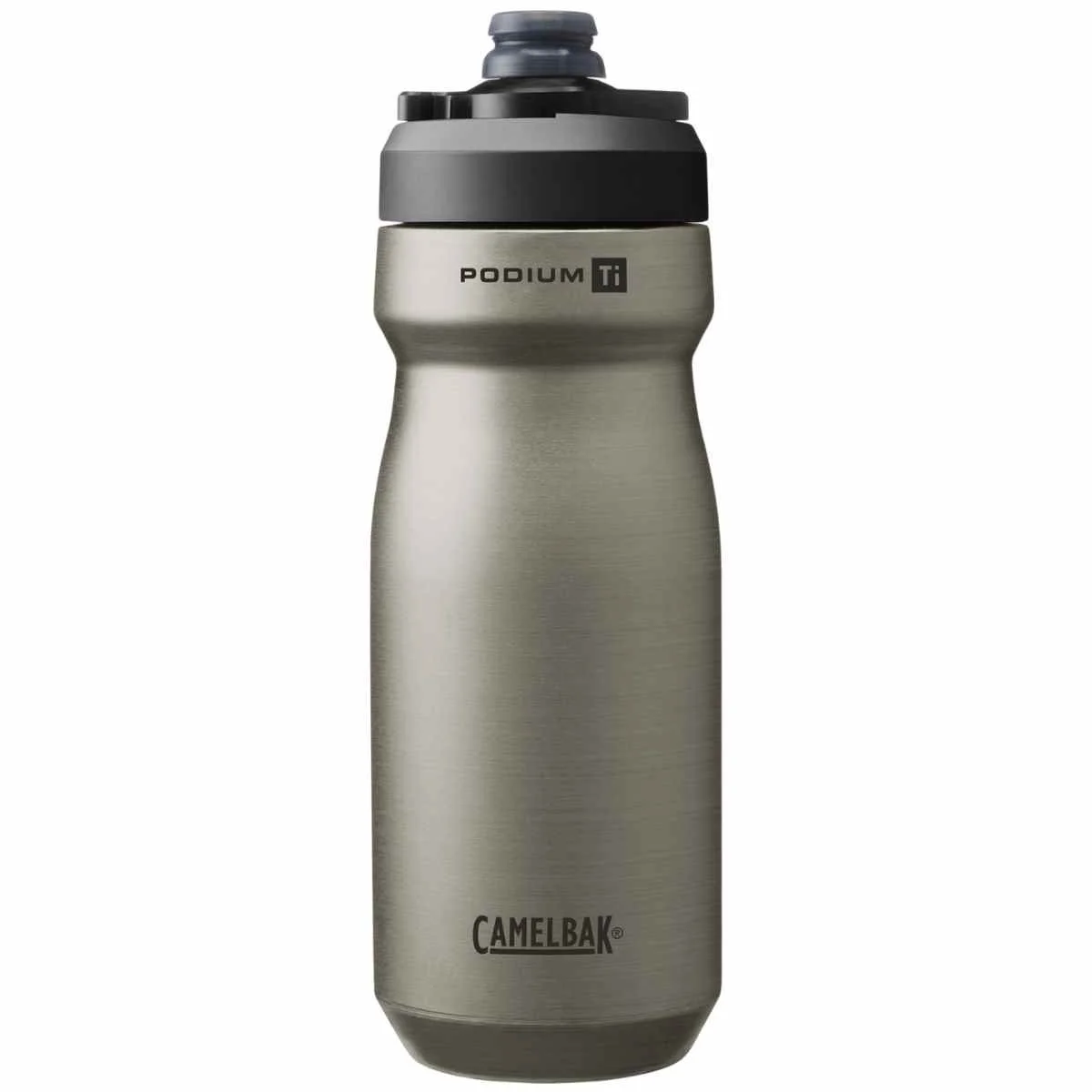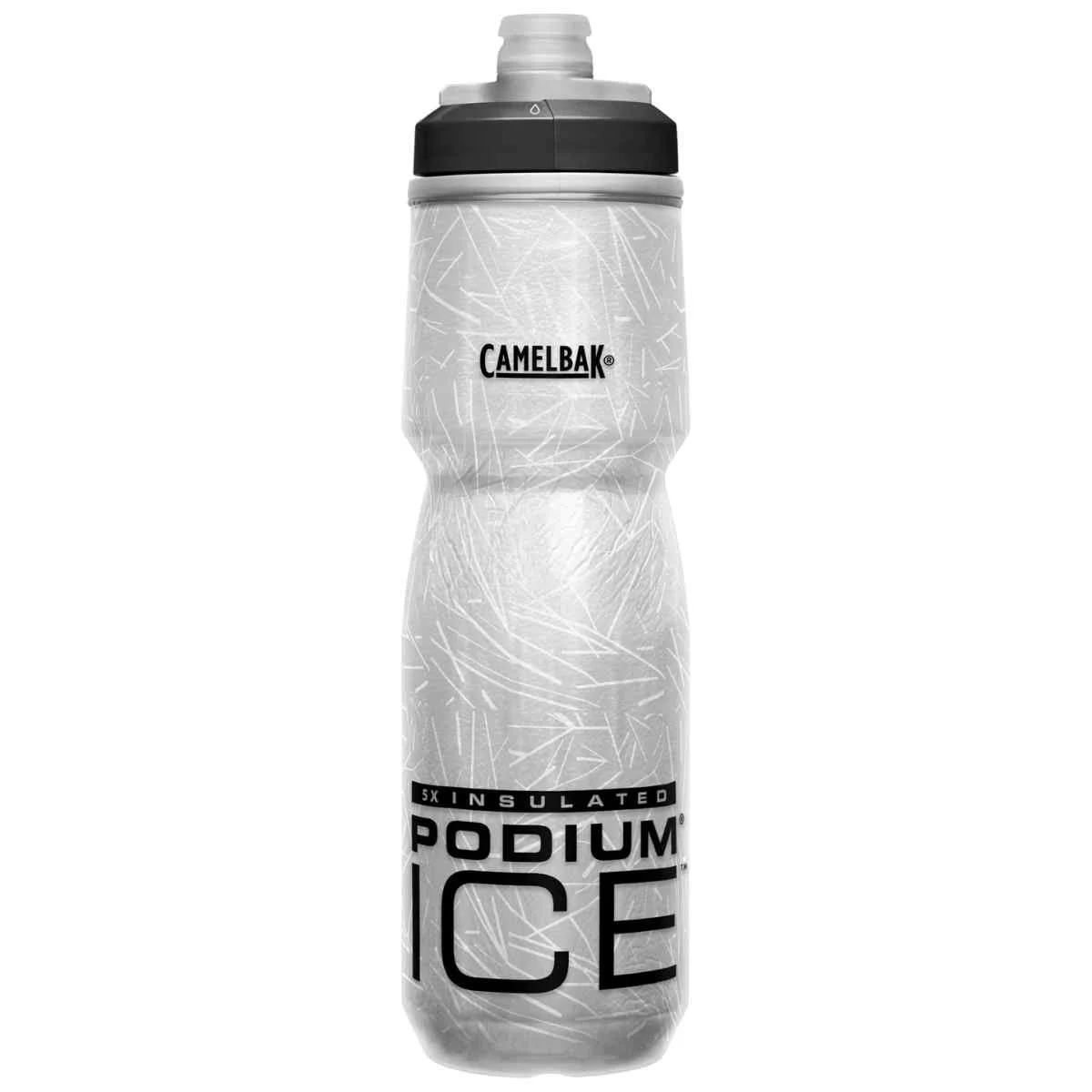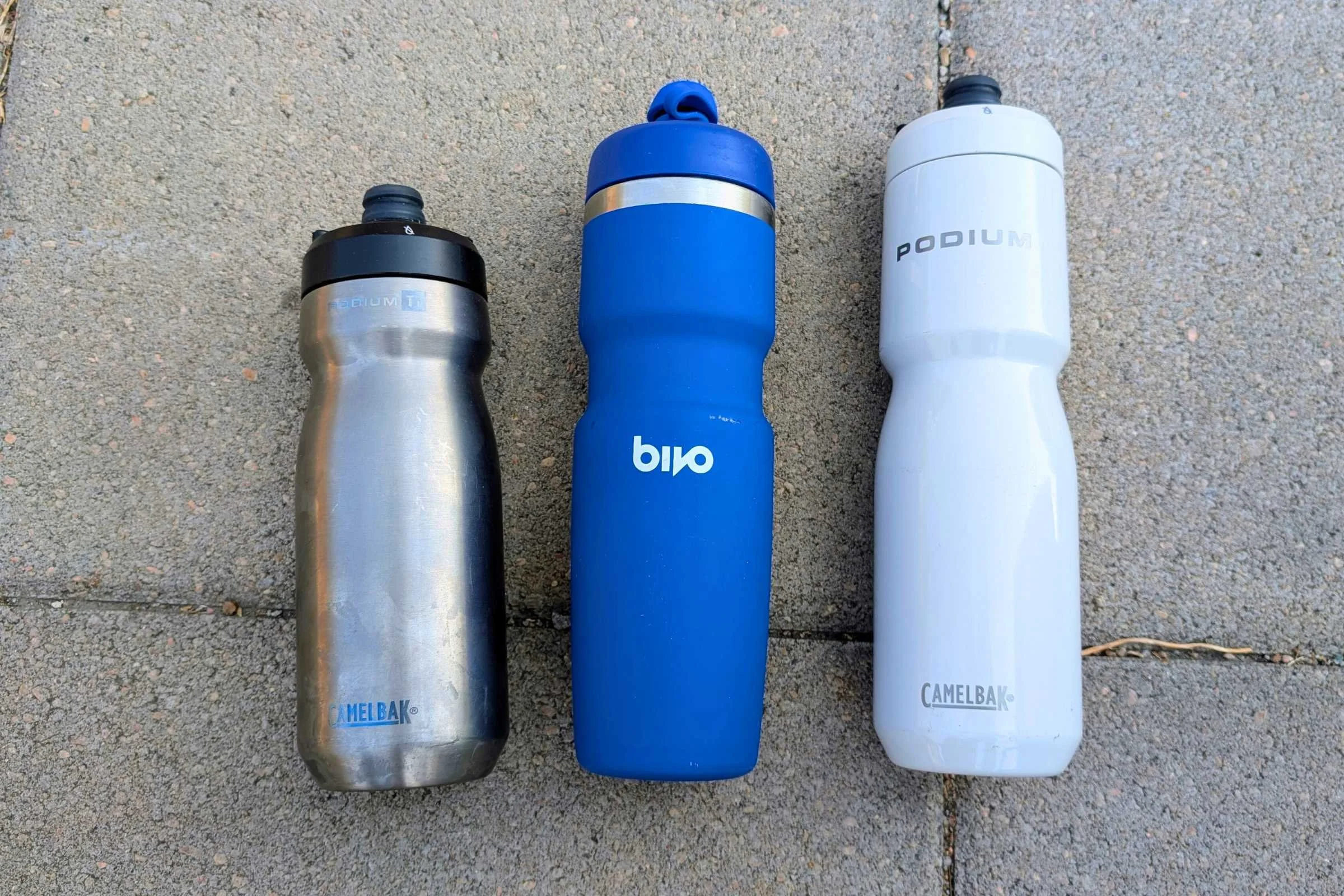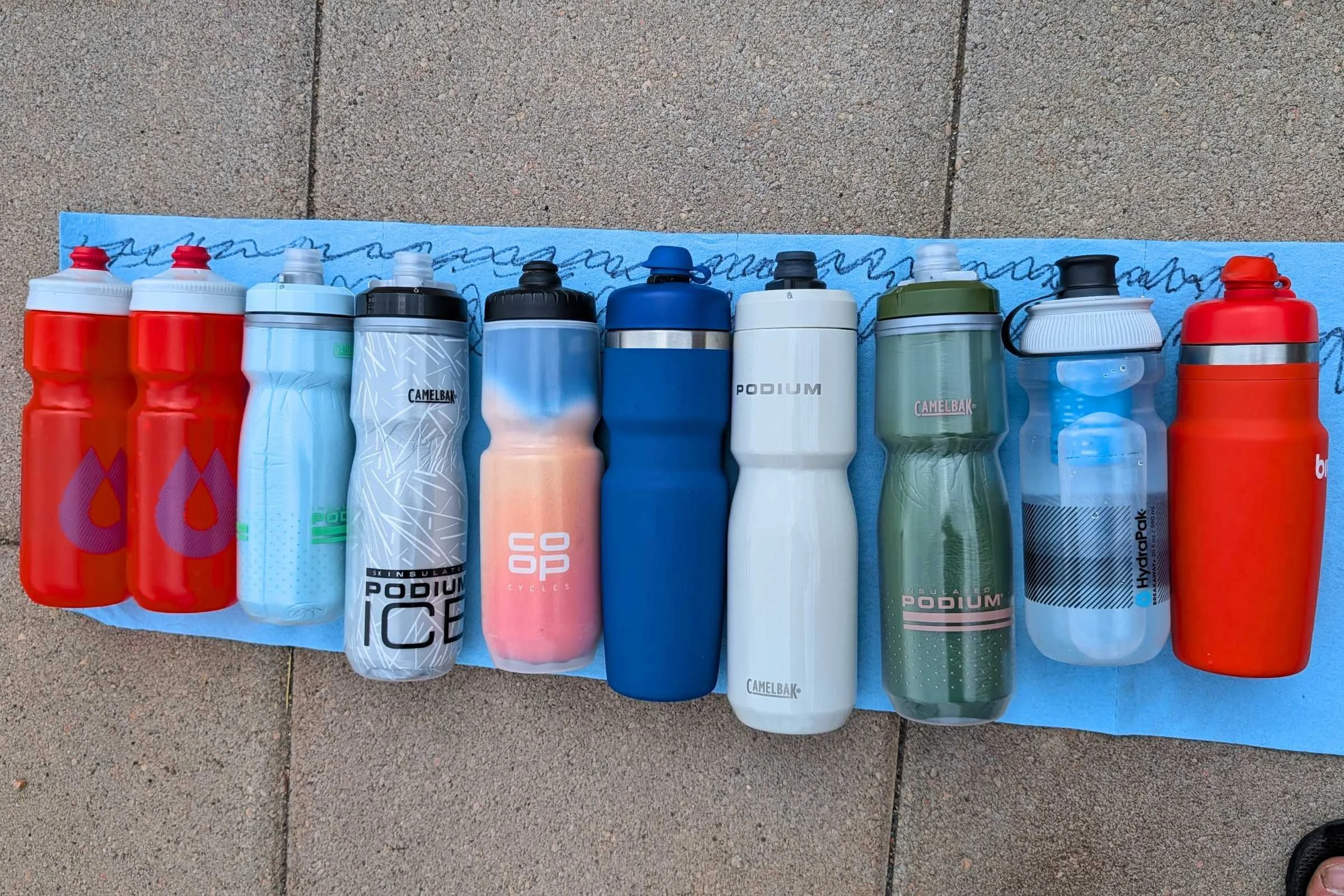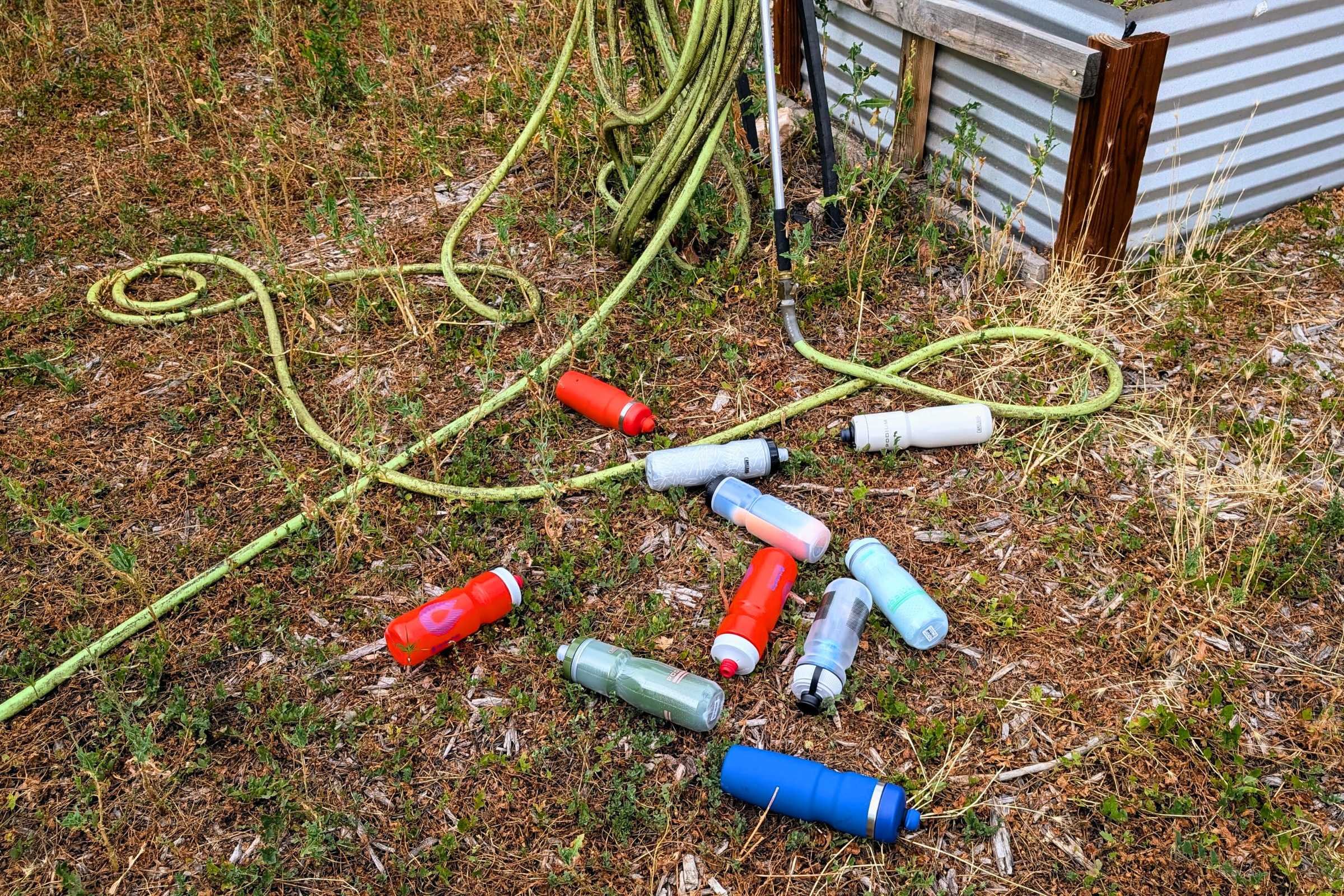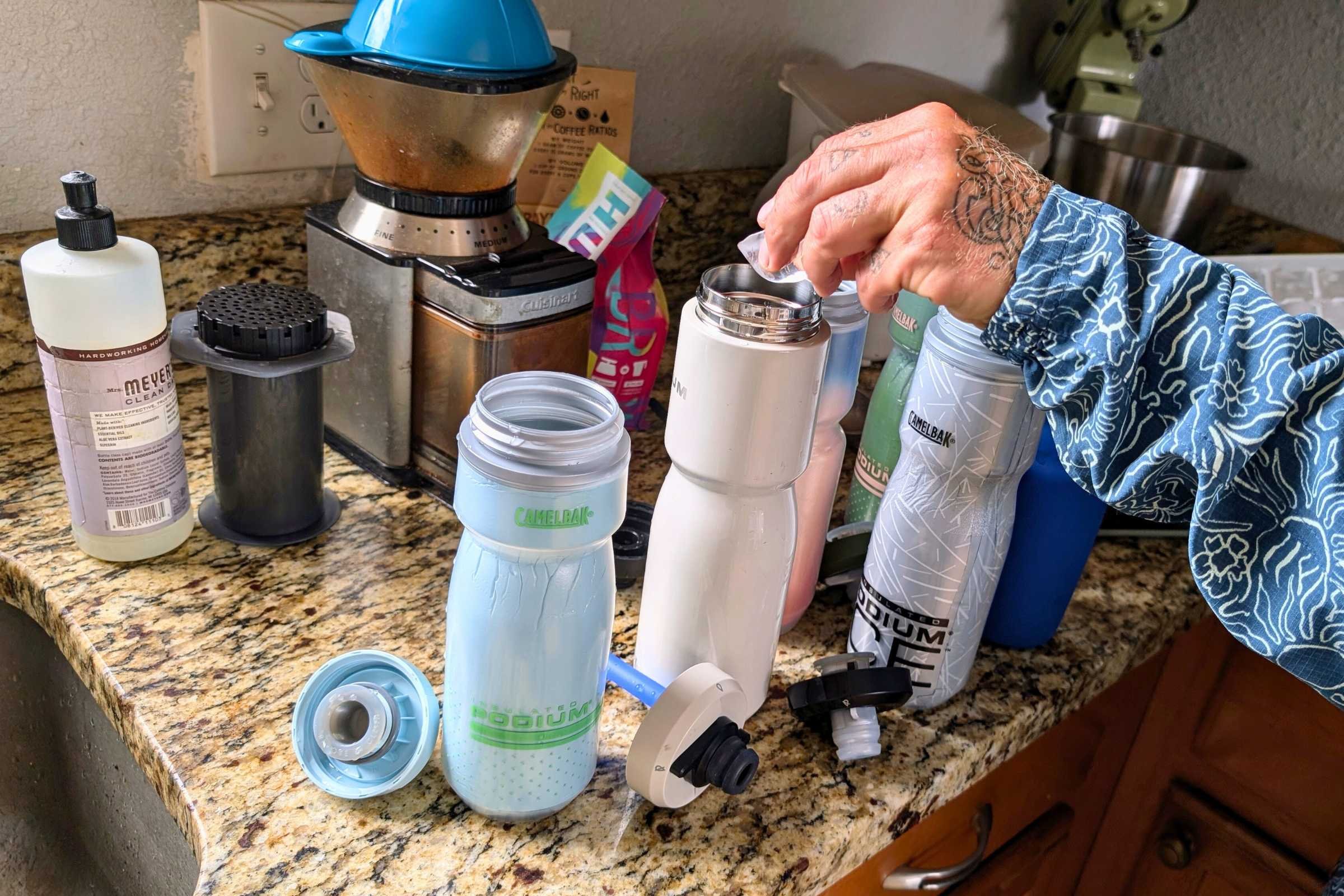Best Bike Water Bottles of 2025
Insulated stainless steel and plastic bike bottles for road biking, commuting, mountain bikes, & bikepacking
August 16th, 2025
Home → Gear Reviews → Bike
To start riding your bike, you will need: a bike, a water bottle, a way to hold that water bottle, and a helmet. That’s all you need.
You don’t need to buy tons of accessories or bike-specific clothing to start riding, but water and something to protect your head are a must. So while the lowly bike water bottle isn’t the most flashy piece of new bike gear, every rider needs water. So you’ll probably use a water bottle more than most other bike items.
Most bike water bottles are pretty effective, and will do what they’re intended to. That is, they hold water in a bike bottle cage on your bike and let you drink that water when you’re thirsty.
But over decades of riding our bike, and countless trips into bike shops to get a new bottle after losing another one, we’ve found there are a few things that make a great bottle. And, you don’t need to spend a lot of money to get a great bike water bottle either.
Our main water bottle tester and the author of this review, Sam, has biked across the United States, spent years using a bike as transportation while living car-free, and bikepacked all over the American West, amassing more than 50,000 miles on his bike. He also worked as a bike mechanic for a decade, where he installed bottle cages on thousands of people’s bikes so they could carry a water bottle on their two-wheeled steed. He’s used every sort of water bottle on his bike, from top of the line bike-specific insulated bottles to cheap freebie bottles and non-bike specific bottles jammed into modified water bottle cages.
Whether you’re looking for a bike water bottle for cruising around town, water bottles for your new gravel bike, an oversized bottle for bikepacking adventures, or something to carry iced coffee on your ride to work, there’s something here that will suit your needs.
We create reader-supported, objective, independently-selected gear reviews. This story may contain affiliate links, which help fund our website. When you click on the links to purchase gear, we may get a commission, without costing you an extra cent. Thank you for supporting our work and mission of outdoor coverage for every body! Learn more.
Comparison table
| BIKE WATER BOTTLE | TREELINE AWARD | MSRP* | WEIGHT | CAPACITY | MATERIAL | DISHWASHER SAFE? | VALVE TYPE | INSULATED? | WEIGHT |
|---|---|---|---|---|---|---|---|---|---|
| CamelBak Podium Chill Insulated | Best Overall Read why |
$18 | 3.5 oz. | 21 oz. | Polypropylene | No | Squeeze | Yes | 3.5 oz. |
| Co-op Cycles Insulated | Best Affordable Read why |
$18 | 3.1 oz. | 23 oz. | Polyethylene | No | Push/ pull | Yes | 3.1 oz. |
| Bivo Trio Insulated | Best Insulated Read why |
$49 | 9.5 oz. | 21 oz. | Stainless steel | No | Sport cap | Yes | 9.5 oz. |
| CamelBak Podium Big Chill Insulated | Best for Road Cycling Read why |
$20 | 4.3 oz. | 24 oz. | Polypropylene | No | Squeeze | Yes | 4.3 oz. |
| Bivo One Lightweight | Best for Mountain Biking Read why |
$39 | 5.6 oz. | 21 oz. | Stainless steel | No | Sport cap | No | 5.6 oz. |
| CamelBak Podium Steel Insulated | Best Stainless Steel Read why |
$44 | 12.5 oz. | 22 oz. | Stainless steel | Yes | Push/ pull | Yes | 12.5 oz. |
| HydraPak Breakaway+ | Best for Bikepacking Read why |
$48 | 3.8 oz. | 20 oz. | TPU, POM, ABS, hollow fiber (filter), silicone, PP | Yes | Squeeze | No | 3.8 oz. |
| Trek Voda | Best High Capacity Read why |
$16 | 4.0 oz. | 34 oz. | Unspecified plastic | No | Push/ pull | No | 4.0 oz. |
The winners
Best overall bike water bottle: CamelBak Podium Chill 21
Capacity: 21 oz.
Material: Polypropylene
Valve type: Squeeze
Insulated: Yes
Leakproof? no
One-handed use? yes if unlocked, and it doesn't leak when unlocked like the metal versions do
Dishwasher safe? No
Weight: 3.5 ounces
What we liked: Ideal size for most people, doesn’t leak, easy one-handed use, insulated, affordable
What we didn’t like: Not as insulating as some bottles, hand-wash only
Picking the best bike water bottle isn’t easy because cyclists come in all shapes and sizes, and do a lot of different types of bike riding. But, for most people, we think the Camelbak Podium Chill 21 is the ideal water bottle. It’s the ideal size—not too big, not too small—so it will fit most bike frames. It makes drinking water while you keep one hand on the handlebars easy. It has an excellent flow rate, and it doesn’t leak.
The Podium Chill’s nozzle design opens automatically when you squeeze the bottle. When the bottle is on your bike, the nozzle stays closed. This design is great because you don’t have to do anything to start drinking water. With other designs, you must pull out a nozzle to start drinking. But with the Camelbak valve, you only have to squeeze the bottle to unlock a strong water spray.
The Podium Chill is insulated but not so insulated that it takes up valuable water-carrying capacity. This bottle will keep your water cold for an hour or so, which means it will keep your water cold for the time it takes to drink.
CamelBak Podium Chill 21
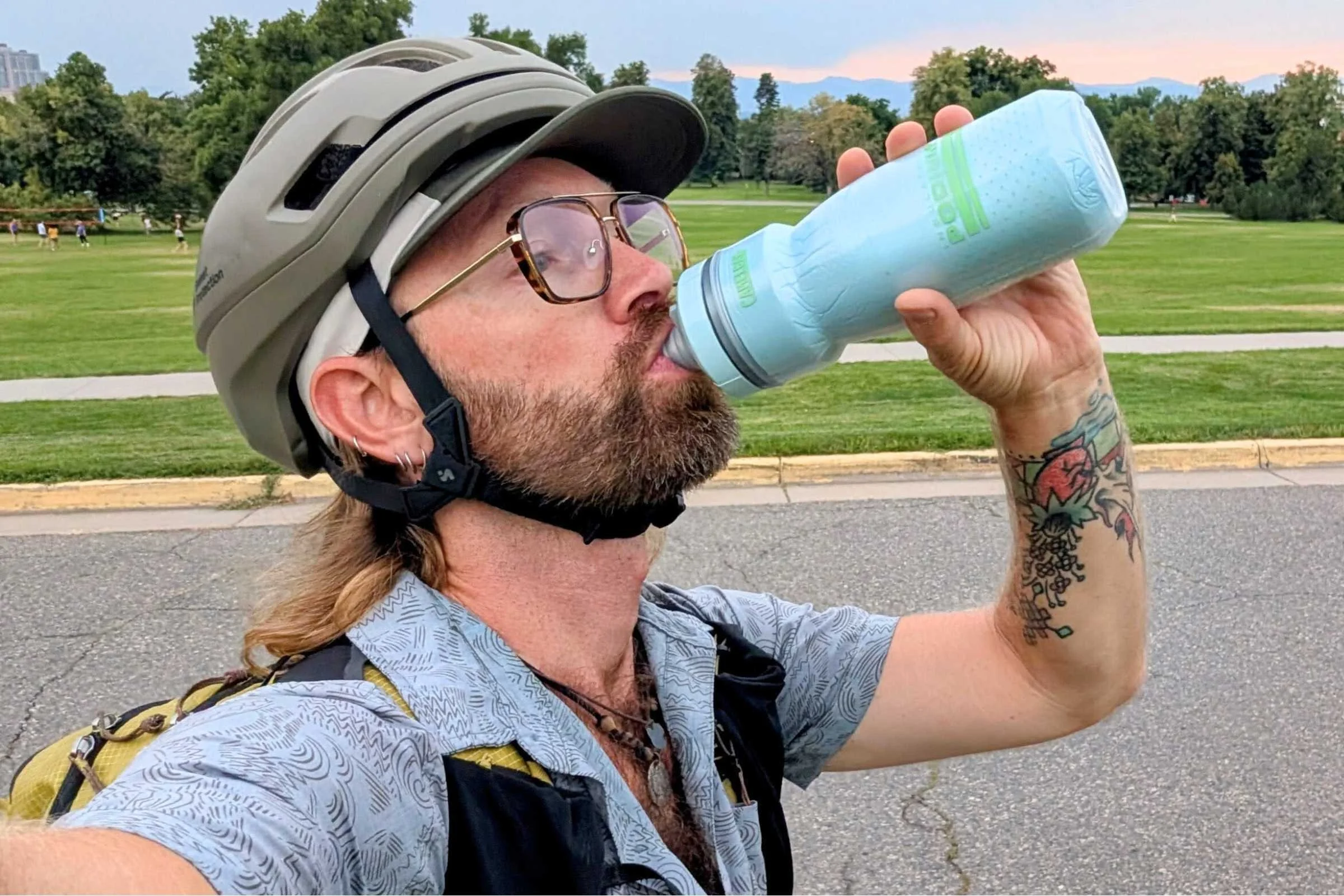



We tested this bottle while riding our bikes around Denver, CO. At first, we weren’t particularly impressed with this bottle. Not because it doesn’t work well, but because there are other bottles with flashier features. The Podium Chill simply does what you need it to. It holds water, and the self-sealing nozzle keeps it inside when riding over bumpy terrain. And if you take the bottle off your bike and throw it in a backpack, the twist lock valve prevents any water from escaping if something in your pack pushes down on the bottle.
We think 21 ounces of fluid is an ideal amount for most riders. If you need more than that, add another bottle cage and another bottle. If the bottle were any larger, it might not fit on smaller frames, mountain bikes, or bikes with a half-size frame bag. This bottle is the perfect size to fit under our Swift Hold Fast Half Frame Bag using a side-entry water bottle cage. If it were any taller, it wouldn’t fit.
The biggest drawback of the Podium Chill is that it isn’t dishwasher safe. If it were a non-insulated bottle, you could wash it in your home dishwasher. However, it’s easy to hand-wash, and you can disassemble the cap for cleaning. To take apart the nozzle, you have to remove two inner pieces, which isn’t the easiest if you aren’t used to working with small parts. But before testing water bottles for this guide, we never felt the need to take apart a lid to this extent for cleaning.
The Podium Chill is the best option for an all-around bike bottle that works just as well on the bike as off the bike. The Podium Chill is also a winner in our Bike Touring Packing List.
Best affordable bike water bottle: REI Co-op Insulated Water Bottle 23 oz
Capacity: 23 oz.
Material: Polyethylene
Valve type: Push/ pull
Insulated: Yes
Leakproof? No
One-handed use? yes and you can lock/unlock with your teeth
Dishwasher safe? No
Weight: 3.1 ounces
What we liked: Affordable, insulated, lightweight, doesn’t leak
What we didn’t like: Not the highest spray pressure
The REI Co-op Insulated Water Bottle is an excellent value for a bike water bottle because it’s easy to use, insulated, and affordable. We tested this bottle on bike rides across Colorado, from the Front Range to high alpine dirt roads. It has a 23-ounce capacity, so it’s slightly taller than the Camelbak Podium Chill, which holds 21 ounces. It’s not too large to fit in most bike frames, but it could be too large for smaller frames or mountain bikes with small center triangles.
The REI Co-op bottle has a push-pull valve. When the valve is pushed shut, no water gets out. Even when we left it tipped over on its side for hours, it didn’t leak. Pulling open the valve with your teeth while holding the bottle with one hand is easy. It’s not as easy as the always-open-but-never-leaks Camelbak Podium valve, but you can lock and unlock it while keeping one hand on your handlebars.
REI Co-op Insulated Water Bottle 23 oz

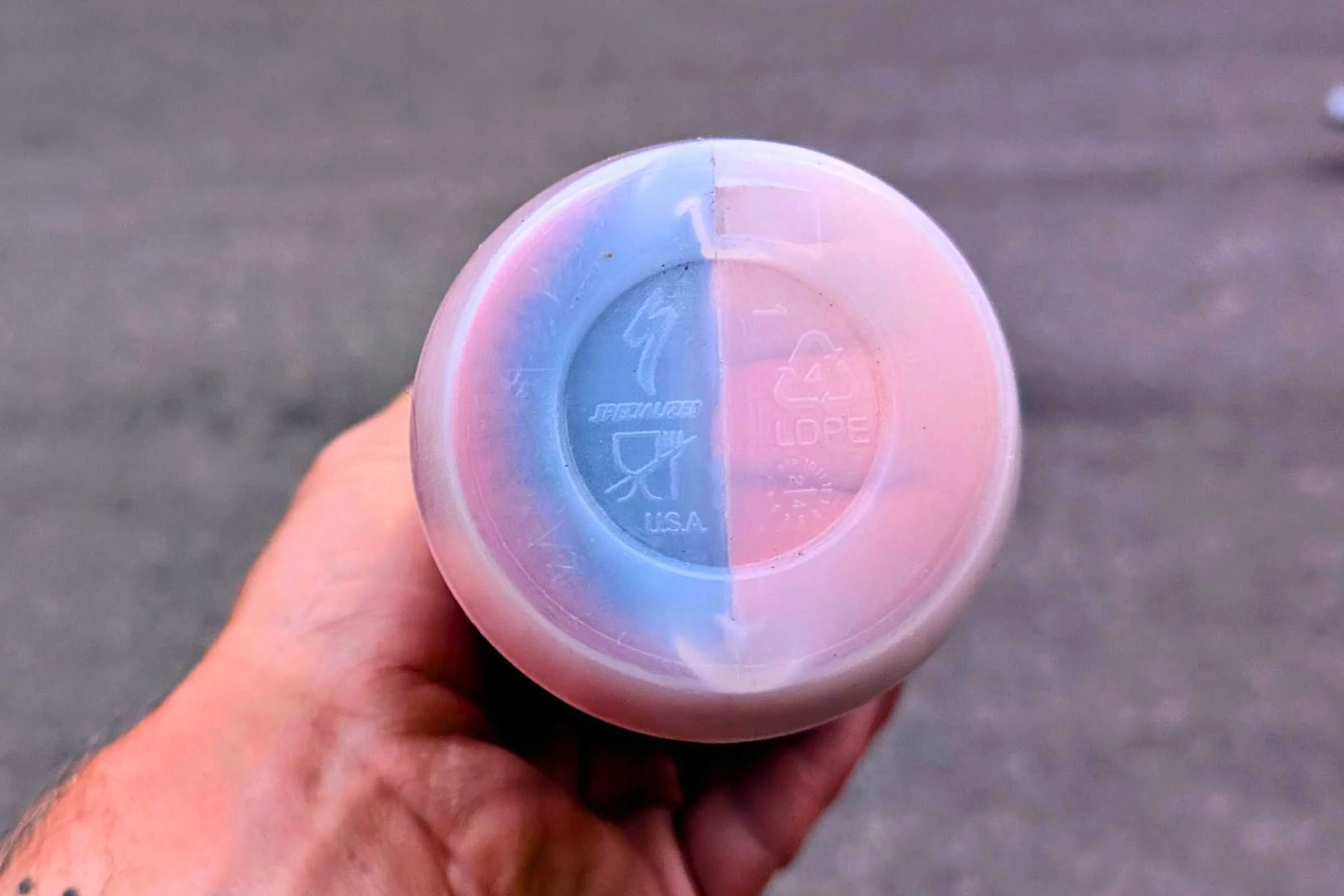



This bottle is insulated but doesn’t have as much insulation as the Camelbak Podium or the most insulated bottles we discuss below. It will keep ice water cold for about an hour in the hot sun. After that, hopefully you’ve drunk all your water, and it’s time for a refill.
The REI bottle’s spray pressure isn’t as strong as the Camelbak Podium. It’s strong enough to shoot water into your mouth quickly, but if you get in a water fight with your friend while riding, you might lose if they have a Camelbak bottle. For drinking, though, it creates enough water pressure.
If you’re looking for an affordable bike water bottle that gives you more ounces per dollar than our favorite bottle, we love the REI Co-op Insulated Water Bottle.
Best insulated bike water bottle: Bivo Trio Bottle 21 oz insulated
Capacity: 21 oz.
Material: Stainless steel
Valve type: Sport cap
Insulated: Yes
Leakproof? No
One-handed use? yes and you can lock/unlock with your teeth
Dishwasher safe? No
Weight: 9.5 ounces
What we liked: Very insulated, doesn’t leak, chemical-free, stainless steel, food-grade silicone nozzle
What we didn’t like: Heavy
The Bivo Trio Bottle is a 21-ounce insulated stainless steel bike water bottle. This bottle keeps drinks shockingly cold for a long time. We filled it with ice water, left it in the hot sun, and checked on it after the sun went down in roughly 4 hours. The water was still icy cold.
It’s a double-walled, vacuum-sealed bottle that doesn’t use lead or other chemicals. We didn’t even know this before testing these bottles, but a common method for making vacuum-sealed bottles is to use a glass bead that contains lead to create the seal. And while not containing lead seems like a low bar, it’s indicative of Bivo’s approach to clean manufacturing.
Bivo Trio Bottle 21 oz insulated
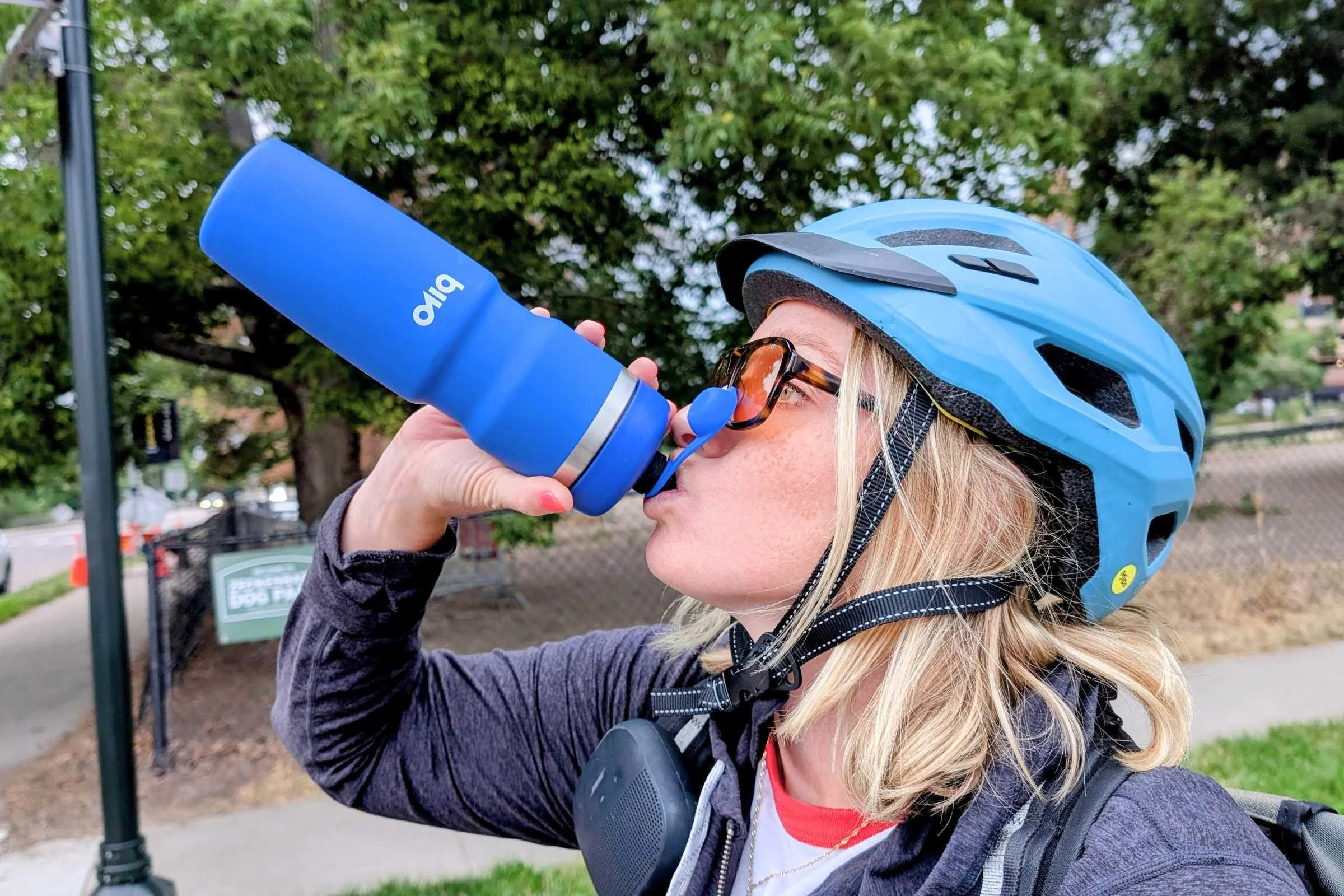
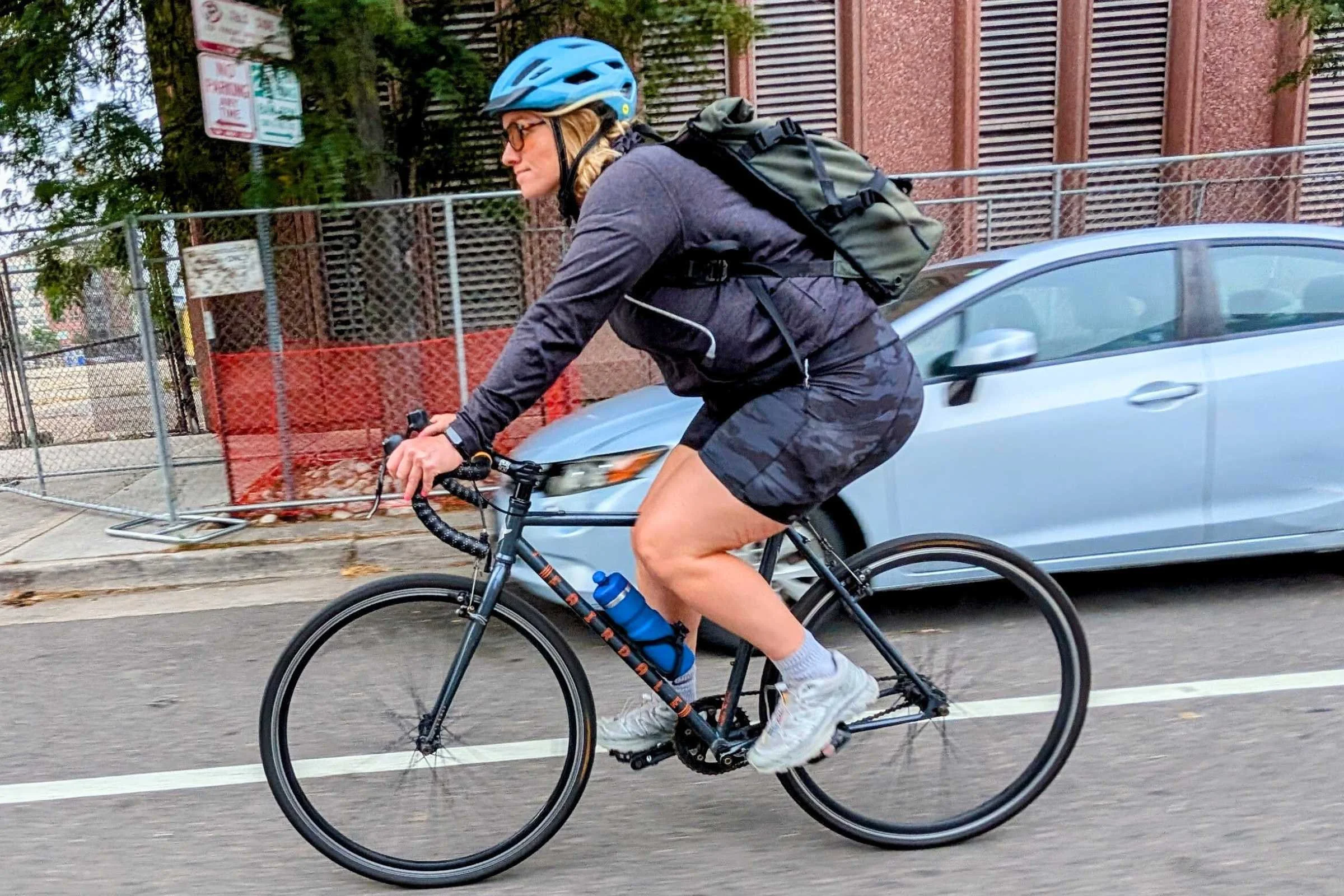
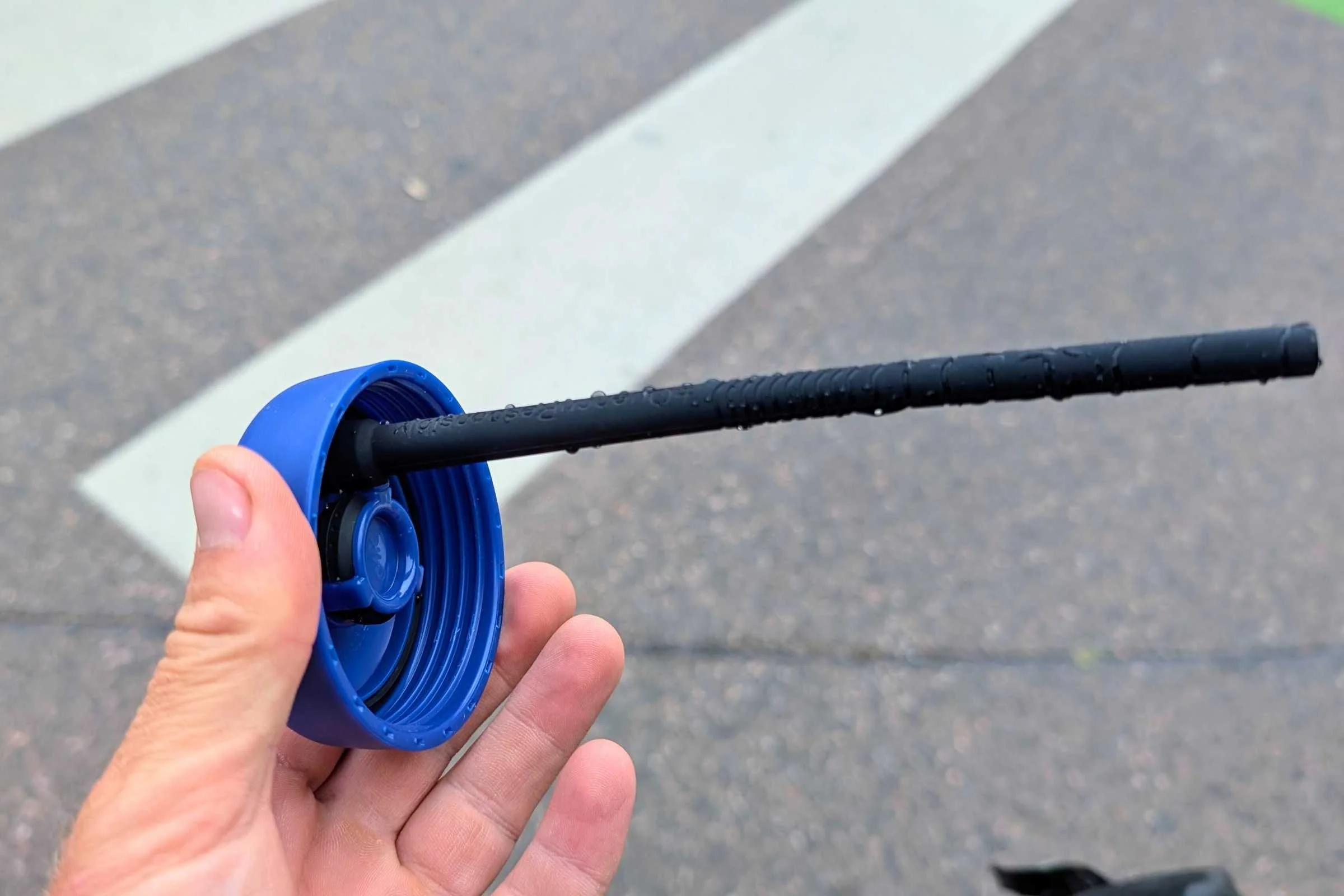
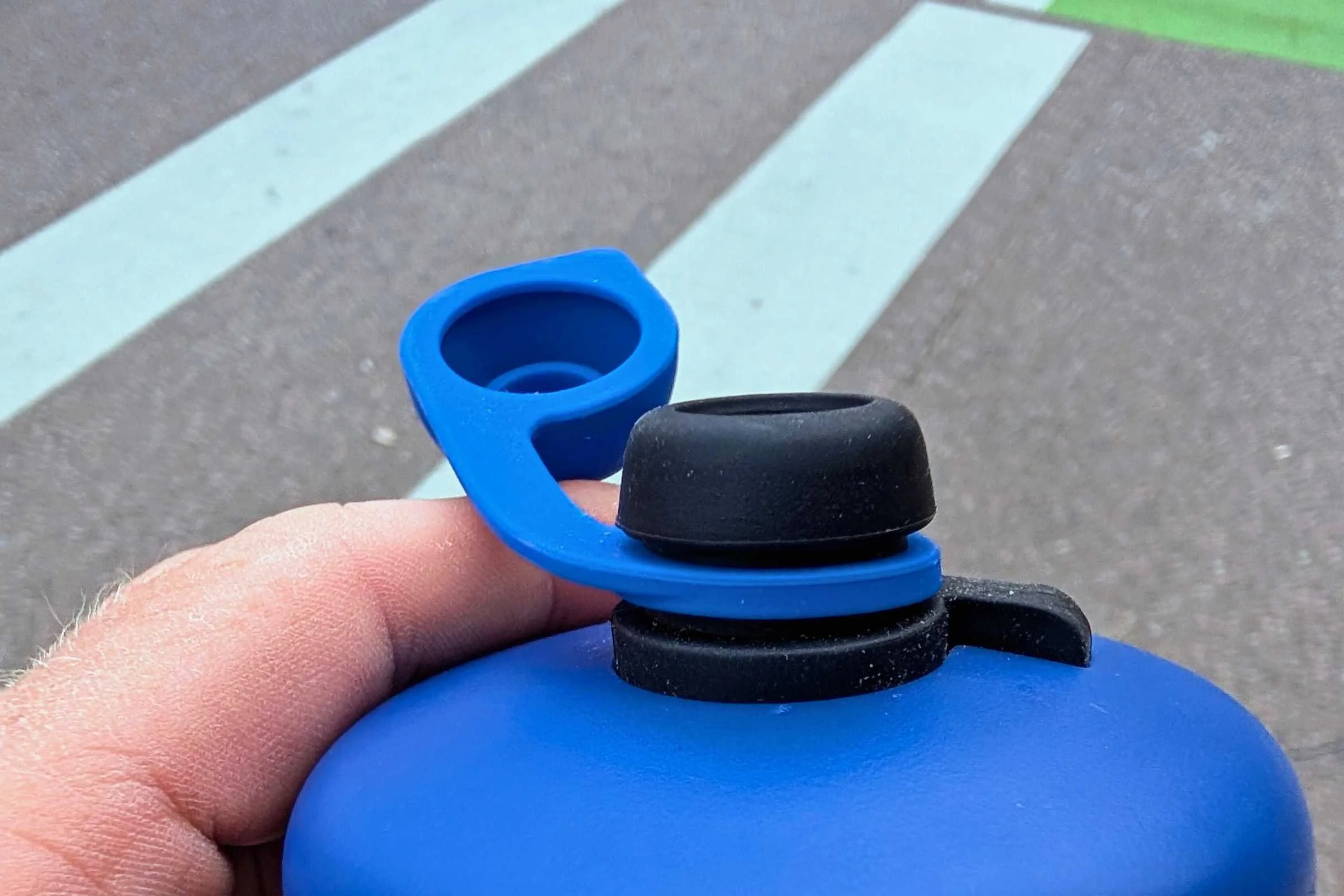
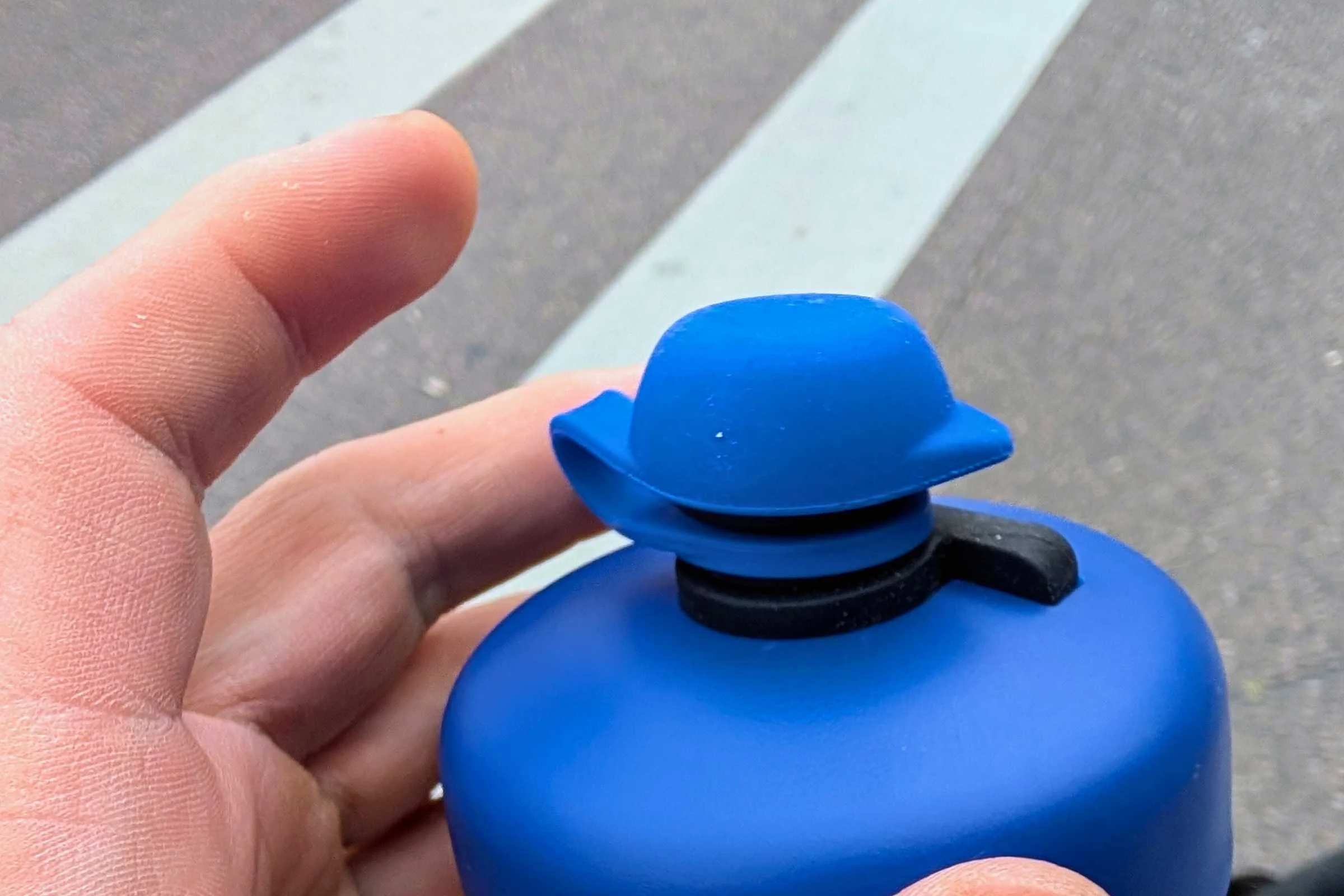
Generally, if you’re concerned with adverse health effects from plastics or other industrial processes, this is the bike bottle for you. Every Bivo bottle is free from bisphenols: BPA, BPF, and BPS. They use food-grade, LFGB-approved silicone (the European, stricter version of the FDA). They test every new color and material they use for phthalates, which are endocrine disruptors. They also test for heavy metals and PFAs, and have found none in any of their materials. And they’re still testing everything in their supply chain to be 100% sure. They’ve written multiple blog posts about plastics, heavy metals, and other unhealthy things in water bottles and food containers.
As a bike water bottle, the Bivo Trio works really well. We’ve never used a steel bike bottle that is this easy to drink from. It has a push-pull valve that doesn’t leak and is easy to open while you ride. And since you can’t squeeze the bottle because it’s steel, it has a silicone tube that lets air in when you invert the bottle, pushing water out through the nozzle. You can add a silicone cap to the bottle to prevent dirt and dust from getting on the mouthpiece.
While we love most things about this bottle, it is much heavier than plastic. And the flow rate isn’t as good as a bottle you can squeeze, so the water will only shoot out as fast as gravity allows.
However, for a double-wall, vacuum-sealed, insulated, stainless steel bike water bottle made by people willing to go many extra miles to test their products for anything that could be bad to put in or near your body—the Bivo Trio is the best option.
Best bottle for road cycling: Camelbak Podium Big Chill 24
Capacity: 24 oz.
Material: Polypropylene
Valve type: Squeeze
Insulated: Yes
Leakproof? No
One-handed use? yes if unlocked, also doesn't leak if unlocked
Dishwasher safe? No
Weight: 4.3 ounces
What we liked: Insulated, great valve, large capacity, lightweight
What we didn’t like: hand wash only, not as insulated, too tall for some frames
The Camelbak Podium Big Chill is our favorite bottle for road bikes because it does everything our overall favorite bottle, the Camelbak Podium Chill does, while holding more water. Road bikes tend to have the largest center triangle of any type of bike, and riding on pavement is hot, so we think the capacity to carry more water is essential for roadies.
The Podium Big Chill will still fit in most bike frames. If you have a particularly small road frame. 48 cm or smaller, this 10.5”-tall bottle might not fit. For reference, it fits in our 54 cm frame with a half-frame bag installed under the top tube, but we have to push the frame bag up and out of the way.
This bottle has the same Camelbak valve we love, with a twist lock for extra leakproof transportation. And it has the same awesome flow rate. It’s also insulated enough for an hour or two; afterward, you’ll have to top off on ice.
If you liked the sound of the Camelbak Podium Chill, but want to carry the most water that will fit in a standard bike frame, you should check out the Camelbak Big Chill 24-ounce bottle.
Camelbak Podium Big Chill 24
Best bottle for mountain biking: Bivo One Bottle 21
Capacity: 21 oz.
Material: Stainless steel
Valve type: Sport cap
Insulated: No
Leakproof? No
One-handed use? yes and you can lock/unlock with your teeth
Dishwasher safe? No
Weight: 5.5 ounces
What we liked: Lightweight for steel, stainless steel construction, chemical and PFAs-free, made with food-grade silicone, nozzle cover keeps dirt off your bottle
What we didn’t like: Not as light as plastic
The Bivo One bottle is a shorter, uninsulated version of the Bivo Trio insulated bottle. And while the Bivo One looks smaller than the Bivo Trio, it holds the same amount of water because it’s only made with a single layer of stainless steel. This bottle isn’t insulated, but it’s otherwise just as great as the Bivo Trio.
We like the Bivo One for mountain biking because it’s shorter, so it can fit in more bike frames, and mountain bike center triangles tend to be smaller than other types of bikes. We also love the silicone cap (which you’ll have to purchase separately) to keep mud and dirt off the nozzle. We can’t tell you how often we’ve spit out that first sip of water on a mountain bike ride because our bottle was covered in mud. Gross.
Bivo One Bottle 21
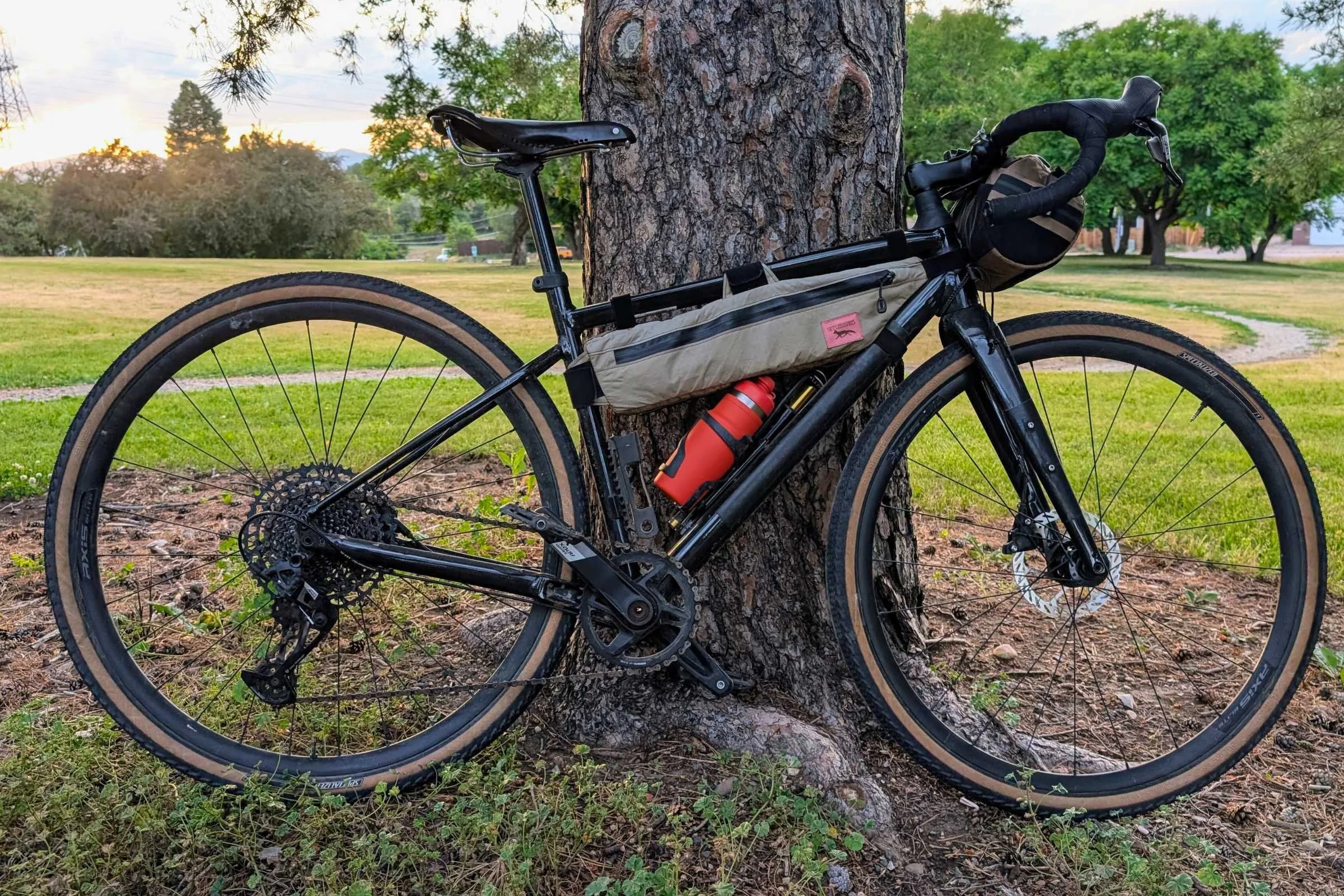
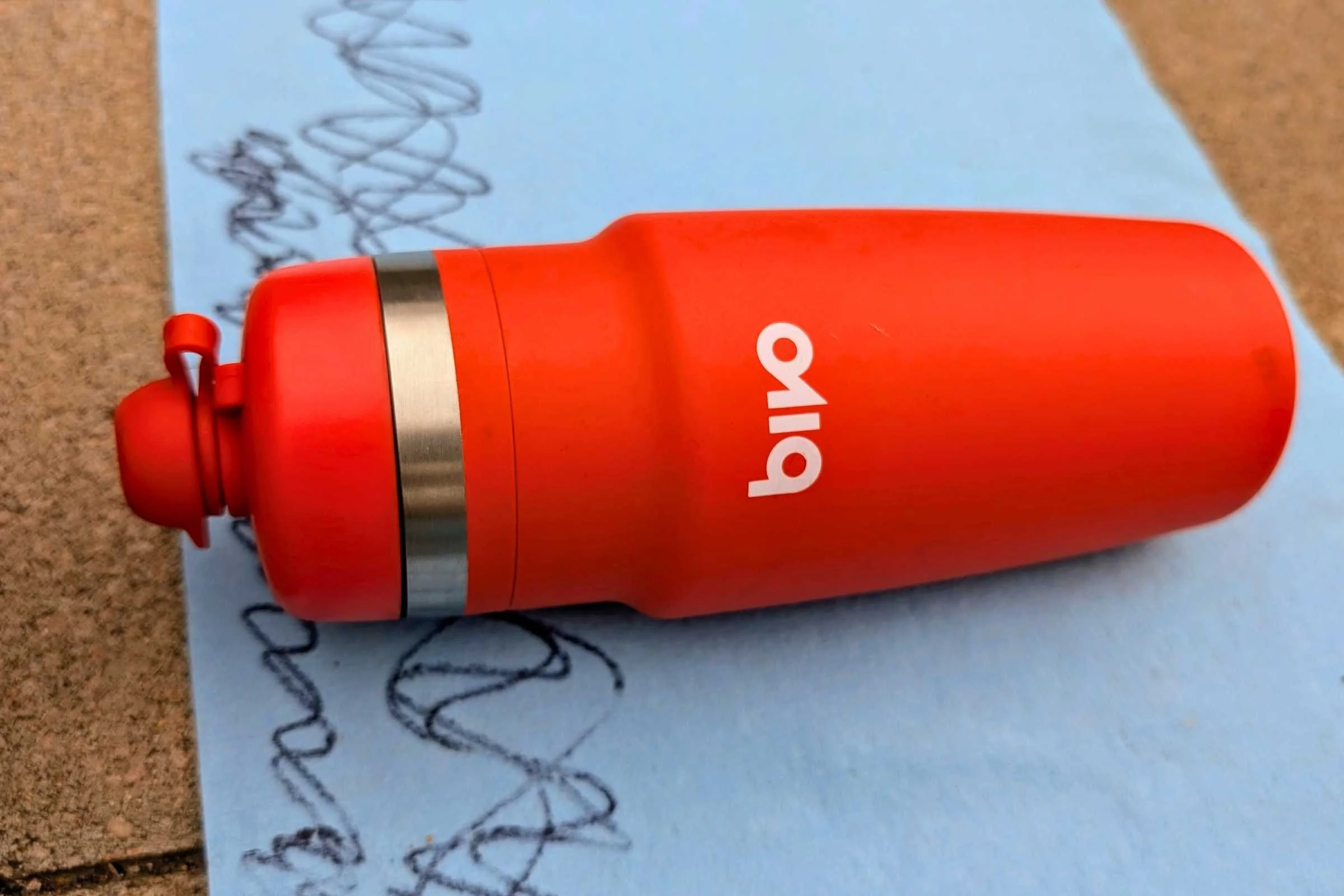
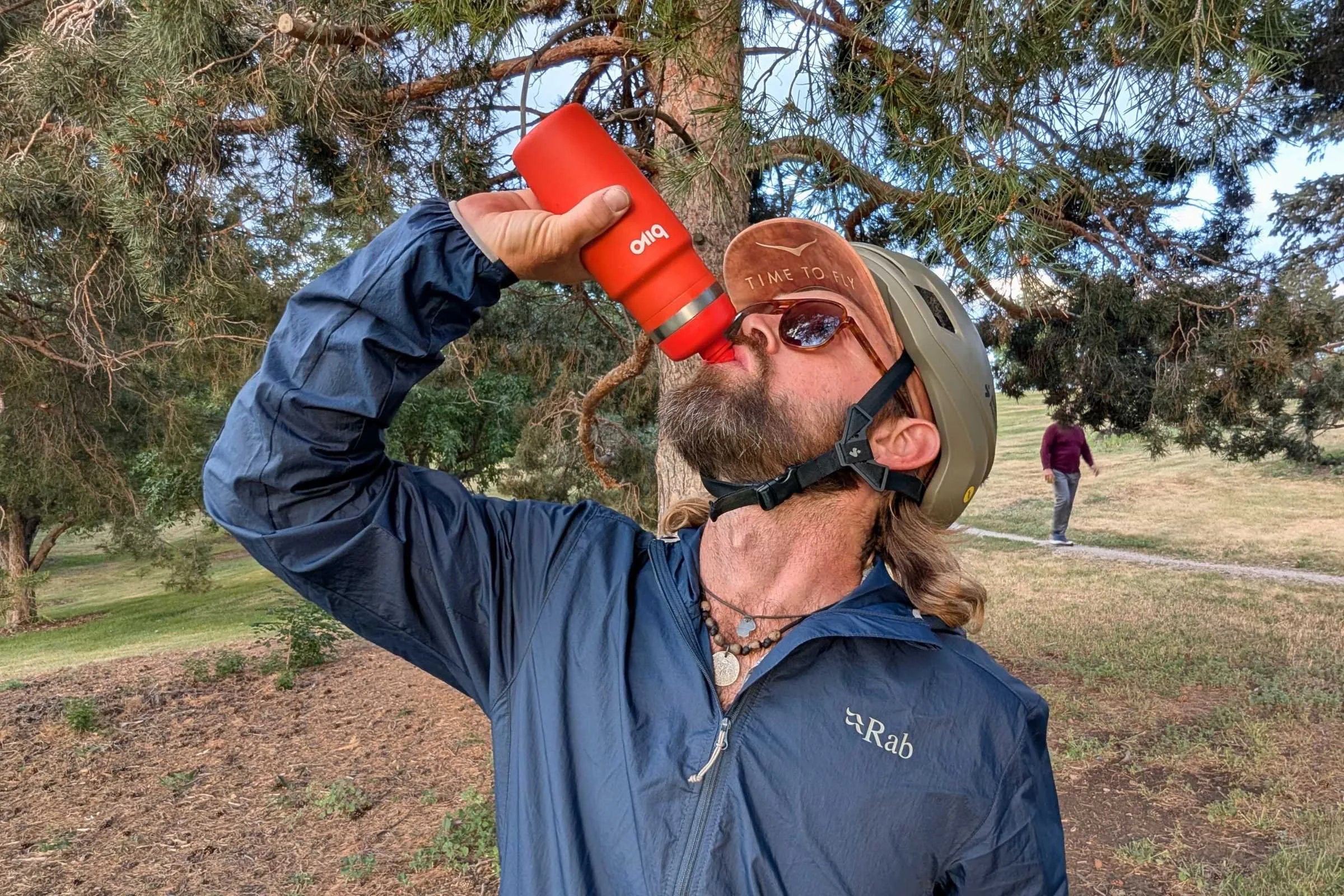
The Bivo One isn’t insulated, so it won’t keep your water cold for long. However, this bottle works almost as well for insulating its contents as some plastic insulated bottles we tested. And as we already mentioned, no insulation means a higher water capacity in a smaller footprint, which is great for smaller bikes.
This bottle is also very durable. You can drop it on rocks, cover it in dirt, and generally use it as you would mountain biking. Yeah, it’ll get dinged up, but the steel construction will last a long time.
If you’re looking for a steel bike water bottle free of chemicals and plastics and liked the sound of the Bivo Trio, minus the double-walled insulation that adds weight, we recommend the Bivo One.
Best stainless steel bike water bottle: Camelbak Podium Insulated Stainless Steel 22
Capacity: 22 oz.
Material: Stainless steel
Valve type: Push/ pull
Insulated: Yes
Leakproof? No
One-handed use? yes if unlocked, but metal style could leak if left unlocked. This isn't a big deal if it's upright, as it would be in a bike bottle cage
Dishwasher safe? Yes
Weight: 12.5 ounces
What we liked: Great insulation, stainless steel construction
What we didn’t like: Hard to use with one hand while riding, heavy
The Camelbak Podium Insulated Stainless Steel is a double-walled, stainless steel version of the Camelbak Podium that we love. This bottle is just as good at insulating as the Bivo Trio. It will keep drinks cold for nearly 24 hours, which is very impressive. We tested this bottle while riding through Colorado during June and July, when the temperatures often pushed near 100.
Camelbak Podium Insulated Stainless Steel 22
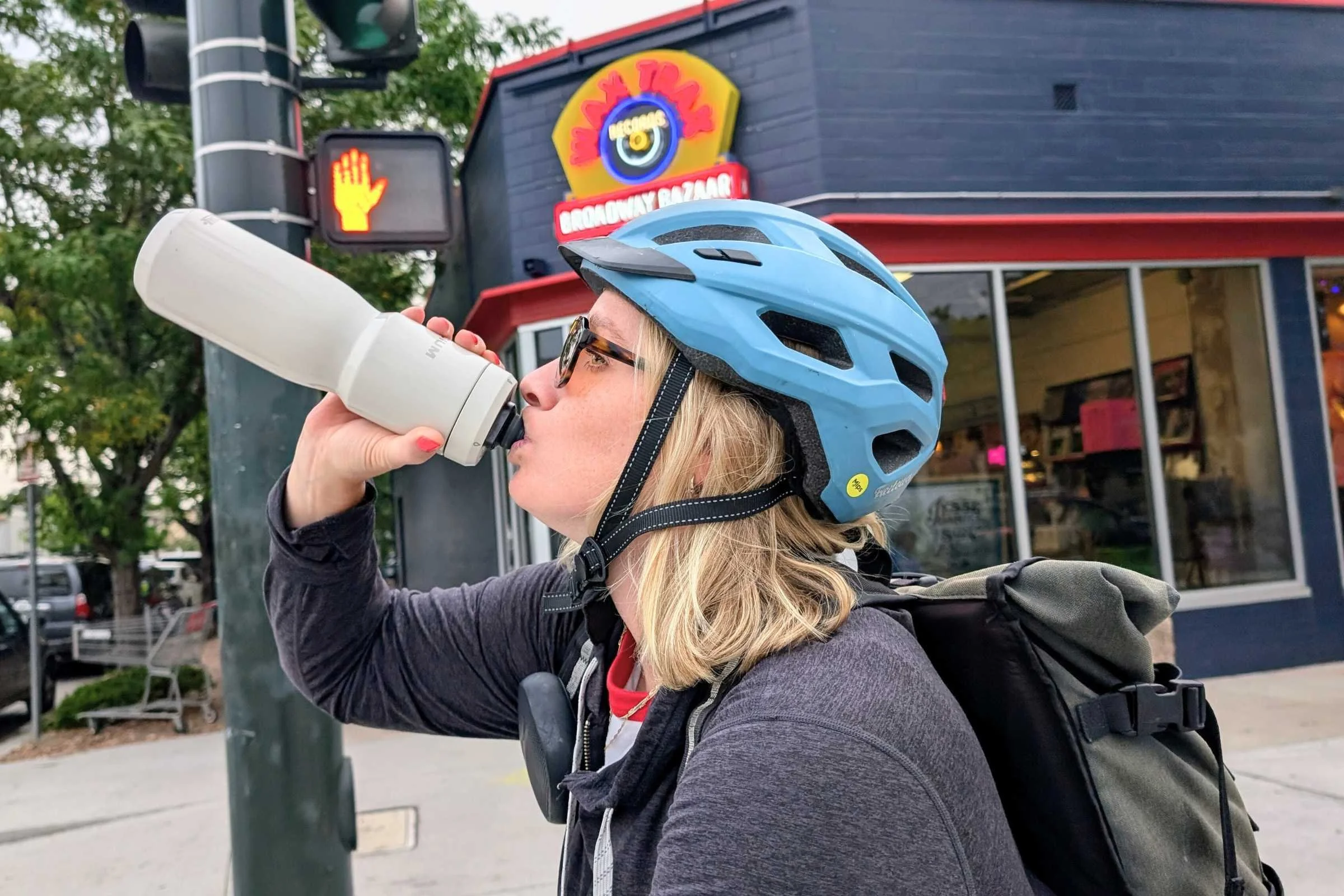
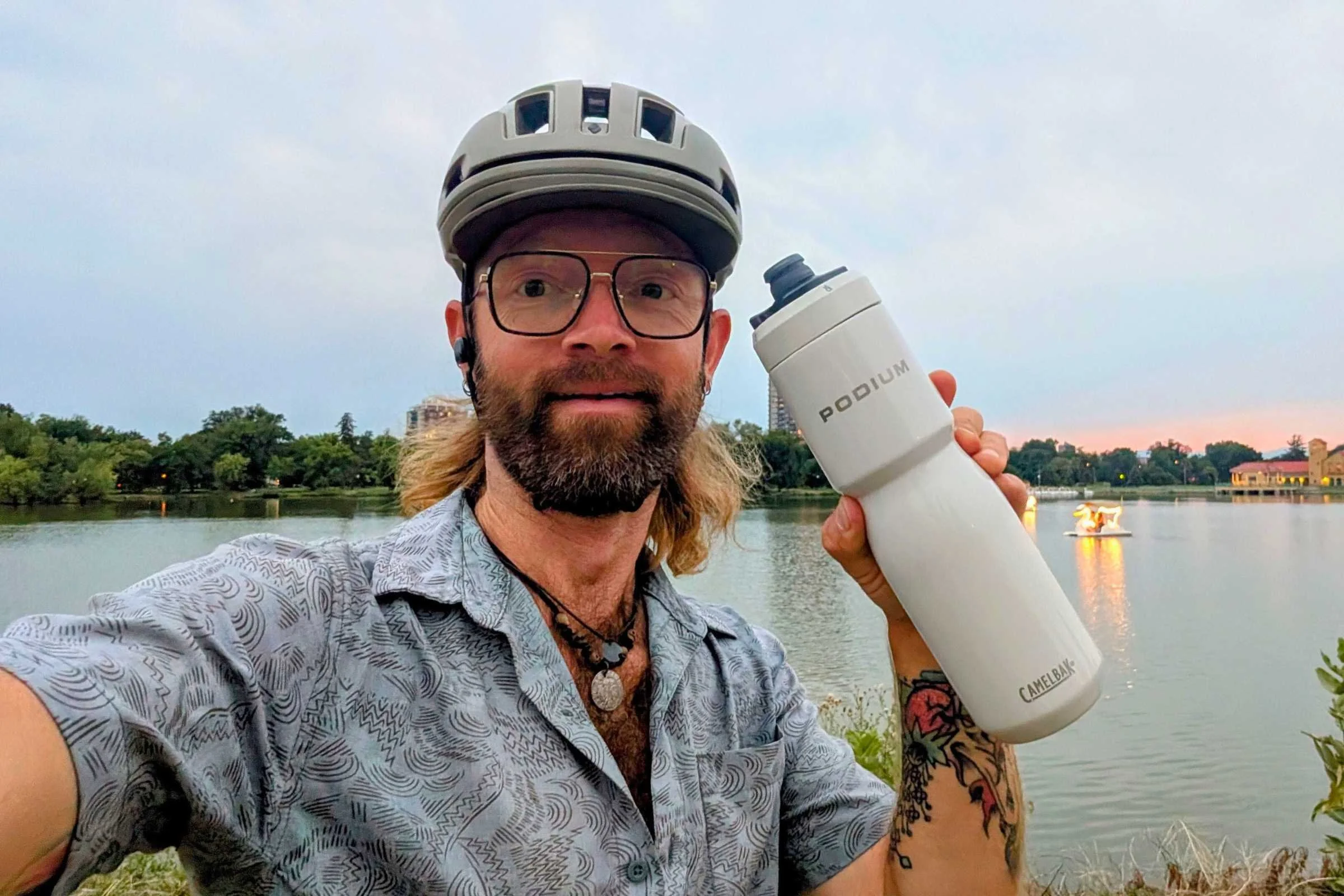
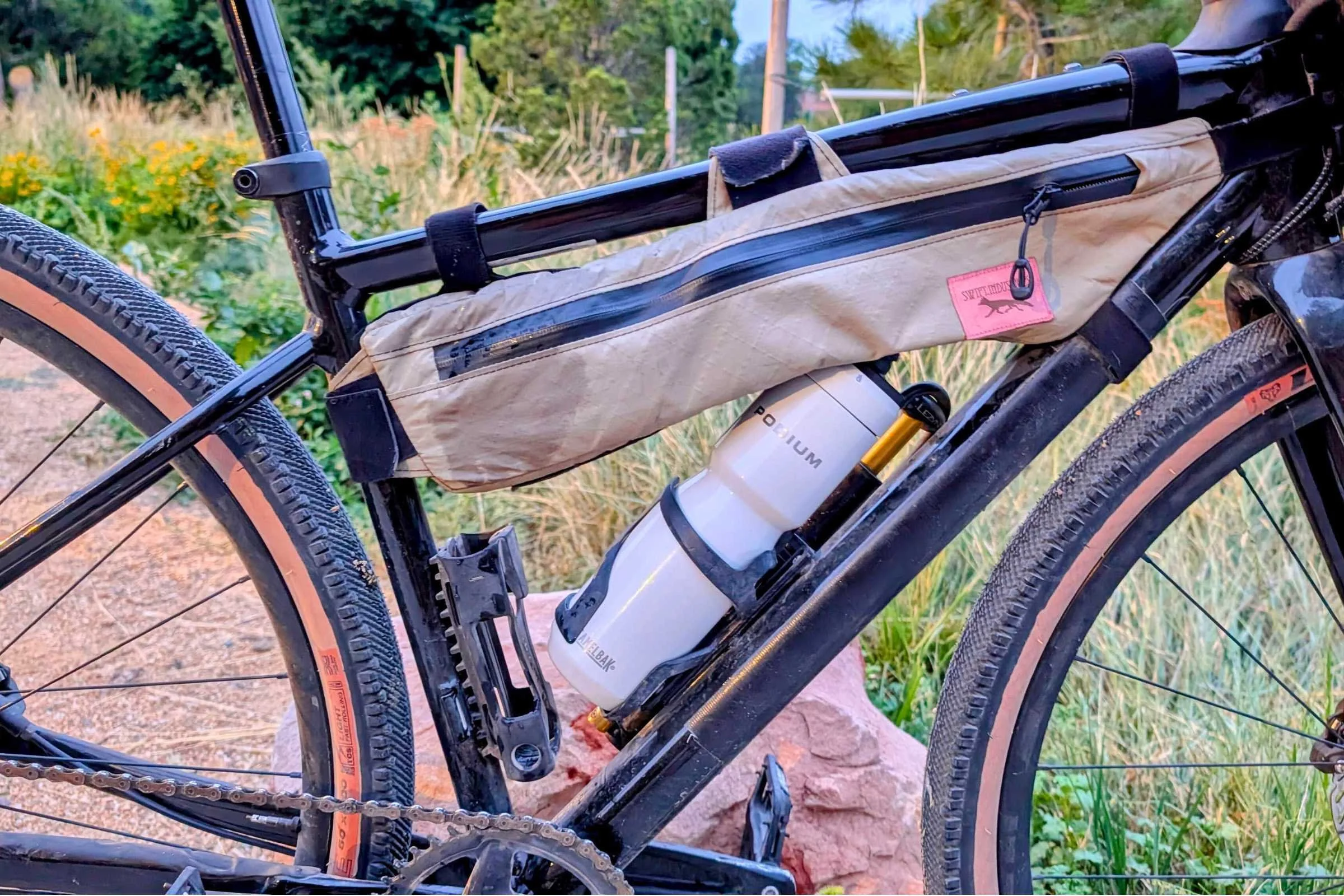
This bottle looks sleek in a way that stainless steel doesn’t always look. It has the same twist-lock valve closure as the other Camelbak Podium bottles. But since it’s steel, and therefore isn’t squeezable, it also has a tube that runs to the bottom of the bottle to allow air to flow in and push water out. When you tip this bottle up to drink, the water pours out. This makes it slightly more difficult to clean, but the tube is removable from the lid, so you can clean it with hot water, a pipe cleaner, or any other way you’d wash a reusable straw.
It has the same twist-lock valve closure mechanism as other Camelbak bottles. This valve works well to prevent any leaking when it's closed. However, when the valve is open, water can come out of the opening if you hit a bump while riding. This is only ever a small amount of water, but some water does get out. Keeping the valve twisted to closed prevents this, but you can’t easily untwist it while you’re riding unless you ride with no hands on the handlebars.
If you’re looking for a stainless steel insulated bike bottle and like the look of this Camelbak Podium Insulated Stainless bottle more than the Bivo Trio, we say go for it.
Best bottle for bikepacking: Hydrapak Breakaway+
Capacity: 20 oz.
Material: TPU, POM, ABS, hollow fiber (filter), silicone, PP
Valve type: Squeeze
Insulated: No
Leakproof? No
One-handed use? yes but twist lock is more difficult than pull/bite nozzle
Dishwasher safe? Yes
Weight: 4 ounces
What we liked: Integrated water filter, lightweight, small size fits in most bikes
What we didn’t like: Not as easy to drink from while riding
The Hydrapak Breakaway+ is a 20-ounce bike bottle with an integrated water filter built into the cap. We love this bottle for bikepacking because, with a filter integrated into a bike bottle, you never have to worry about finding your filter when you get to a stream crossing. Since this filter is integrated into the bottle, you don’t have to carry an extra bottle or filter bag, as you would with other lightweight water filters.
The bottle itself is an ultralight plastic and very easy to squeeze. The filter's flow rate is fast when it’s new, but we expect it will slow down with more use. It removes 99.99% of E. coli and parasitic cysts. To filter water, you fill the bottle and replace the filter cap, then squeeze the bottle to force unfiltered water through. The nozzle is a soft rubber, much like other bike bottles. It also has an integrated cover to keep mud and dirt off the nozzle. It also comes with a backflush adaptor to clean your filter after your trip.
Hydrapak Breakaway+


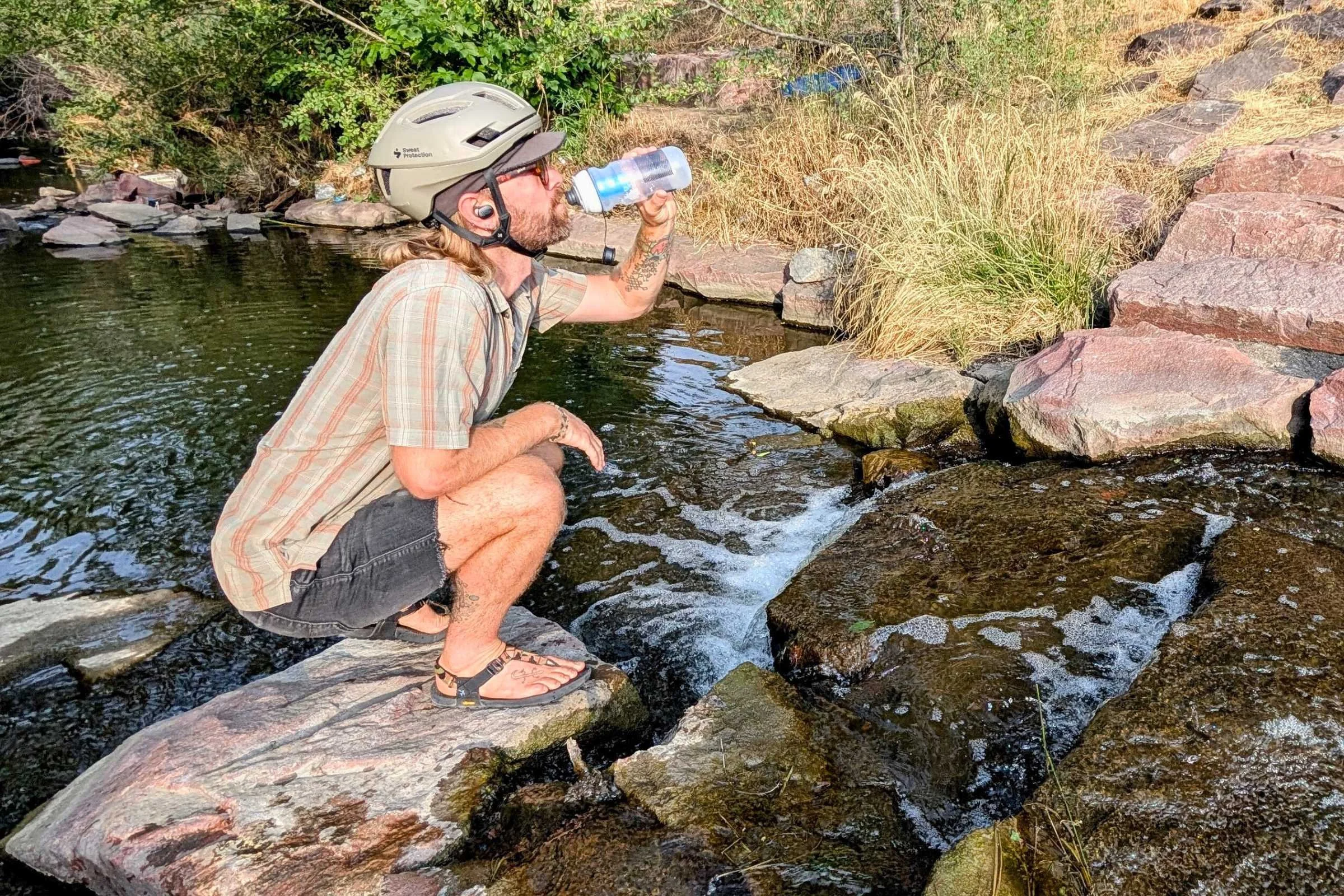

The filter cap twists shut so it won’t leak water while you ride. And while it’s difficult to twist open with one hand, it’s not impossible to twist it open. If you grip the nozzle with your teeth and twist with your hand, you can drink freshly filtered water while riding.
This bottle-and-filter combo comes in two sizes: 20 oz, which we tested, and 30 oz. We like the smaller size because it’s more versatile and can fit on smaller frames or a frame with a half-frame framebag installed. But if you’re planning a desert bikepacking trip, the 30-oz version might be a better option because it will allow you to carry more water.
Best high capacity bottle: Trek Voda
Capacity: 34 oz.
Material: Unspecified plastic
Valve type: Push/ pull
Insulated: No
Leakproof? No
One-handed use? yes and you can lock/unlock with your teeth
Dishwasher safe? No
Weight: 4.1 ounces
What we liked: Massive water capacity, fits in standard bike bottle cages
What we didn’t like: Doesn’t fit on smaller frames
The Trek Voda is the largest bike water we’ve found. This thing is massive. It will hold more water than a 1-liter Nalgene bottle. And unlike a Nalgene, this works with a standard bike bottle. We use two of these bottles to securely hold over 2 liters of water in a pair of bottle cages mounted to the fork of our bikepacking bike.
It has the same profile as a standard bike water bottle, but is much taller to hold more water. It has a push-pull rubber valve to lock it closed and doesn’t leak when you have it closed. It’s not insulated and is a pretty basic bottle, besides the fact that it’s really tall.
Trek Voda


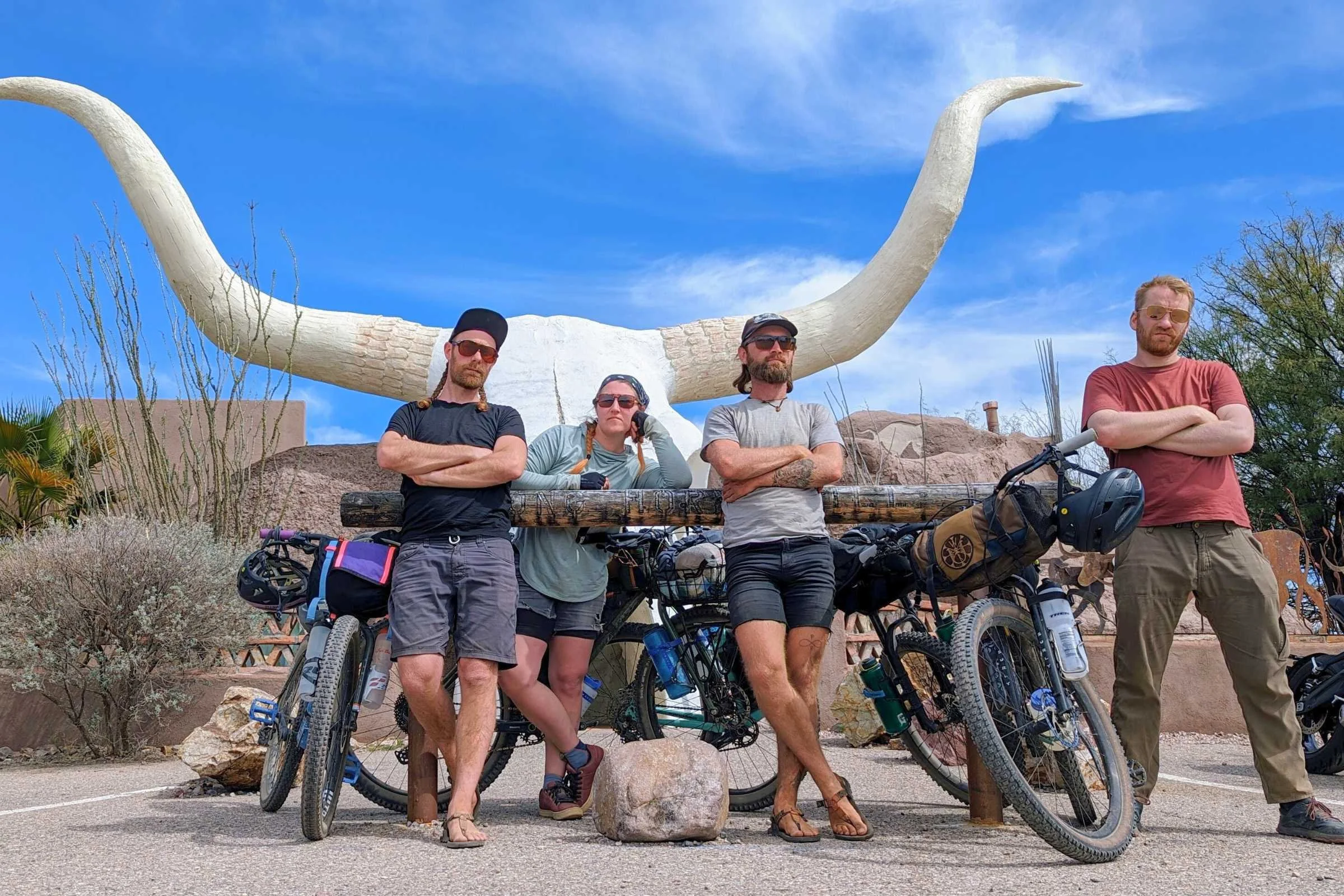
The biggest downside to this bottle is that it only fits on larger frames. Trek claims it works on M to XL bikes, and we’ve successfully mounted it in the center triangle of a medium Surly Ogre with a side access water bottle cage. While it worked there, it barely fit in our frame. But, if you have a larger frame or have bottle cage bosses on your bike’s fork, two of these mounted onto the fork will seriously increase your water carrying capacity.
There are Nalgene-specific bike water bottle cages that you could use to hold larger water bottles on your bike, but those don’t have the easy-to-open nozzle of a bike-specific water bottle. On the other hand, the Voda is easy to open and drink with one hand, as long as you can reach wherever you mount it.
Other bike water bottles we tested
Hydrapak Breakaway Surge 25 (2 pack)
Capacity: 25 oz.
Material: PP, TPU, HDPE, LDPE, PE, silicone
Valve type: Squeeze
Insulated: No
Leakproof? yes, one of the two bottles leaks. If you screw in the lid really tight it doesn't leak as much, but still does slightly
One-handed use? yes and you can lock/unlock with your teeth
Dishwasher safe? Yes
Weight: 2.6 oz
What we liked: Lightweight, comes in a two pack, affordable
What we didn’t like: Cap threads can leak
The Hydrapak Breakaway Surge is a fantastic deal for two bike water bottles. This two-pack costs about as much as any single bottle we tested here. We were stoked to find these bottles, and they have an easy-to-open push-pull nozzle for drinking while riding. They’re also lighter than any bottle we tested.
However, in our leak test, these were the only bottles that leaked from where the cap screws onto the bottle. They didn’t leak much, but they did leak a little. We wouldn’t recommend storing these full of water in your duffel. If you’re very intentional about screwing on the cap as tightly as possible, that mostly solves the leaking issue. So while these are a great deal and do everything you want a bike water bottle to do, we can’t recommend them over the other bottles that don’t leak at all.
Hydrapak Breakaway Surge 25 (2 pack)
Capacity: 18 oz.
Material: Titanium
Valve type: Sport cap
Insulated: Yes
Leakproof? No
One-handed use? yes if unlocked
Dishwasher safe? Yes
Weight: 8 oz
What we liked: Very light for a metal double-walled bottle, durable
What we didn’t like: Expensive
The Camelbak Podium Ti is the only double-walled, vacuum-insulated, titanium water bottle we’ve found. If you liked the sound of the Camelbak Stainless Steel Insulated Bottle we discussed above, but want a much lighter version, this is a great option.
However, we’ve buried the lede. This bottle is twice as expensive as the stainless steel Camelbak bottle. We get it; titanium is expensive, and everything titanium costs more, but we were shocked to see the $100 price tag on this bottle. That being said, it's pretty great if you want a titanium bottle for your titanium bike and are willing to spend the money.
Camelbak Podium Ti
Capacity: 21 oz.
Material: Polypropylene
Valve type: Squeeze
Insulated: Yes
Leakproof? No
One-handed use? yes if unlocked, and it doesn't leak when unlocked like the metal versions do
Dishwasher safe? No
Weight: 5 oz
What we liked: More insulated than other plastic Camelbak Podium bottles
What we didn’t like: More insulation means lower capacity
The Camelbak Podium Ice is a 21-ounce bottle that works just as well as our favorite bottle, the Podium Chill. The Podium Ice has more insulation, so it will keep your drinks colder for longer than the standard insulated Podium bottles.
However, we weren’t as impressed with the insulation as we’d hoped. This bottle doesn’t work as well at insulating as the stainless steel Podium, Podium Ti, or the Bivo Trio. And the Podium Ice is more expensive than the standard Podium Chill. Furthermore, all that extra insulation cuts down on water-carrying capacity. The Podium Ice holds 21 ounces of water but is the same size as the 24-ounce Camelbak Podium. And if the insulation will only work so-so, we’d rather have more water.
Camelback Podium Ice 21
What to look for in a bike water bottle
Camelbak Podium Titanium, Bivo Trio, and Camelbak Podium Stainless, side by side (left to right).
Here’s what to look for in a bike water bottle.
Valve style
There are several different valve styles commonly used on bike water bottles: bite, push-pull, twist, and lockout. Here’s a rundown of each valve type.
Push-pull valve
These valves open when you pull them out and close when you push them in. Old school “sport” water bottles usually have this type of valve. They’re easy to open and close with your mouth.
The REI Co-op Insulated Water Bottle, Hydrapak Breakaway, Trek Vado, Bivo Trio, and Bivo One all have push-pull valves.
Twist Valve
These valves open when you turn them. They’re slightly more difficult to open while riding a bike than a push-pull valve, but if you grip the valve with your teeth and turn the bottle with your other hand you can open it while keeping one hand on the handlebars.
The Hydrapak Breakaway+, which has a built-in filter, uses a twist valve closure. The Camelbak Podium Ti and Camelbak Podium Insulated Stainless Steel 22 also have a twist locking mechanism to prevent water from leaking out as you ride.
The Camelbak Podium Big Chill Camelbak Podium Ice 21, and Camelbak Podium Chill 21 also have twist locking mechanisms, but those also lock out automatically, so the twist lock is extra.
Lockout Valve
Lockout valves are any kind of valve that closes on its own when you aren’t squeezing the bottle.
The Camelbak Podium Big Chill 24, Camelbak Podium Ice 21, and Camelbak Podium Chill 21, which we mentioned above, all use a self-sealing lockout valve so they won’t leak water unless you squeeze the bottle. The pressure from squeezing is what opens the valve.
Bite valve
These valves open when you bite them. These aren’t as common on bike water bottles as other valves. Because you have to pinch the valve with your teeth to make the water come out, they’re less ideal for drinking and riding.
Squeezeability and flow rate
All of the plastic bottles we tested are squeezable, and these have the best flow rate as well. Steel and titanium bottles aren’t squeezable, so they don’t have as strong of a flow rate.
The plastic bottles we cover here are Camelbak Podium Big Chill 24, Camelback Podium Ice 21, Camelbak Podium Chill 21, Hydrapak Breakaway 25, Hydrapak Breakaway+, REI Co-op Insulated Water Bottle, and Trek Vado. The plastic Camelbak bottles also have the strongest flow rate, because their self-sealing valves create a burst of pressure when you squeeze them, causing a strong flow of water.
Insulated vs. non-insulated
If you want your drink to stay cold, an insulated bottle is best. However, the insulation added to a bottle takes up space. So, the same sized insulated bottle won’t hold as much water as a non-insulated bottle with the same exterior size.
For instance, the Camelbak Podium Ice 21 and Camelbak Podium Big Chill 24 have nearly identical exterior dimensions, but the Big Chill 24 holds three extra ounces of water than the Podium Ice 21.
Similarly, the Bivo Trio Insulated 21 and Bivo One 21 hold the same amount of water. But the Bivo One is significantly shorter because it’s not insulated.
We found that the double-walled metal bottles are far better at insulating than any of the plastic insulated bottles we tested. These steel and titanium bottles are as effective at insulating as a double-walled coffee tumbler, and you can even use them for hot drinks.
The insulated metal bottles we tested are the Bivo Trio Insulated 21, Camelbak Podium Insulated Stainless Steel 22, and Camelbak Podium Ti 18.
Of these bottles, the Camelbak Podium Stainless Steel keeps drinks colder slightly longer than the Bivo Trio Insulated. Either of these bottles are about as good as it gets with insulation, and they’ll keep ice water cold for nearly 24 hours.
The Camelbak Podium Ti doesn’t keep drinks as cold for quite as long, but it still insulates for hours—just 6 or 7 instead of 18–20 hours. All the metal bottles we tested were shockingly better at keeping ice water colder in direct sunlight than any insulated plastic bottle.
The insulated plastic bottles we tested are the Camelbak Podium Big Chill 24, Camelbak Podium Ice 21, REI Co-op Insulated Water Bottle 23, and Camelbak Podium Chill 21. While these bottles do have insulation, after an hour in direct sunlight the ice water inside them was only slightly cold.
The Camelbak Podium Ice 21, which has the thickest layer of insulation, kept its ice water the coldest of any plastic bottle. But even this model’s ice water was only slightly chilled after an hour in direct sunlight, so it doesn’t compare to the steel and titanium bottles in terms of insulation.
Fit with standard cages
Every bike water bottle we tested here fits with standard bike water bottle cages. Any bottle that claims to be for a bike should fit in standard bike water bottle cages. Look for the indentation about 6 inches from the base of the bottle. If a water bottle has a narrower portion six inches from its base, it will likely fit in a bike water bottle cage.
Taste and material safety (e.g., BPA-free)
If you’re after the purest-tasting drinks, one of the stainless steel or titanium bottles is best.
The Bivo bottles we tested, the Bivo One 21, and Bivo Insulated 21, use food-grade silicone, plastics 100% free from bisphenols, and stainless steel without any heavy metals or lead. It’s common to use a lead ring in the manufacturing of double-walled stainless steel water bottles, but Bivo uses a glass ring instead. Every Bivo bottle meets the European REACH standard (the European equivalent of the FDA), which is stricter than the American Prop 65 (FDA) standard.
Bivo also does voluntary country tests that go beyond REACH, specifically tests for Italy, the Netherlands, and France. They did all of these more thorough tests to find out if they had any chemicals in their manufacturing process. Read this for more on Bivo’s testing and materials choices, and if you’re really interested, read this for even more.
The Camelbak Podium Stainless Steel and Podium Ti are BPA-free. Camelbak states that, “No CamelBak-manufactured bottles have lead components that would come in contact with a liquid, or with a product user.” Although they do use a solder that contains lead, “Some bottles have a solder point on an exterior wall, and that solder does contain lead, but the solder is enclosed under a protective cover and is inaccessible by design. The only way this solder would be accessible is if a user purposefully and intentionally misused or destructed the product.”
All of the plastic bottles we tested are BPA-free. The Camelbak Podium models, the Podium Chill 21, Podium Ice, and Podium Big Chill 24, are lined with Camelbak’s TruTaste Polypropylene. These work the best at keeping your water from tasting like plastic of the squeezable plastic bottles.
The Trek Voda 34, Hydrapak Breakaway 25, Hydrapak Breakaway+, and REI Co-op Insulated are all BPA free, but if you leave them in the sun for long enough they will taste different. The water doesn’t taste plasticky, per se, but it doesn’t taste as pure as out of a metal water bottle.
Ease of cleaning
The Camelbak Podium Stainless Steel Insulated, Camelbak Podium Ti, Hydrapak Breakaway Surge 25, and Hydrapak Breakaway+ (minus the filter cap) are dishwasher safe.
The Hydrapak Breakaway 25 has an easy-to-disassemble lid for cleaning. The silicone nozzle twists out of the plastic thread on the lid.
The Bivo lids are as easy to disassemble as the Hydrapak lid. Since the Bivo bottles are stainless steel, they also have a straw that forces air into the bottle so you can drink without squeezing. So, the lid comes apart into three pieces. But the food-grade silicone nozzle pops out of the lid, and the air tube straw slides on and off easily. Bivo also provides a food-grade silicone pipe cleaner for cleaning the inside of the air tube.
The lids on the Camelbak Podium squeeze bottles can also be disassembled for cleaning, but there are four pieces instead of two, and we honestly wouldn’t have taken this lid apart if we weren’t mechanically inclined.
Leakproof design
When storing your water bottle in a bike bottle cage, it’s not tipped in a way that makes it likely to leak, but you still don’t want your water bottle to leak in case you’re transporting it in a commuter bag before or after your ride.
When we tested these bottles for leaks, the only bottle that leaked with the valve closed was the Hydrapak Breakaway 25. This bottle leaked a few drops when laid on its side over the course of an entire afternoon. While this isn’t much, it’s more than you’d want to leak if you were transporting the bottle inside a bag.
Most of these bottles will leak water if the valve isn’t closed. The exception is the Camelbak Podium squeezable bottles—the Ice, Chill, and Big Chill. These bottles won’t leak if their twist valve is left open unless the bottle is squeezed.
Durability and drop-resistance
All of these bottles are durable and can be dropped on the ground. The plastic bottles are less likely to show scratches, but they’re water bottles that will be regularly removed and replaced from water bottle cages, so they’ll get some scratches.
One-handed use
You should be able to remove a water bottle from the bottle cage, then drink from the bottle with one hand. If you can’t, you’ll have to stop riding to take a drink.
Most of these bottles can be used with one hand, but some are easier than others. Bottles with a push-pull valve are easy to open with your mouth, so you can leave one hand on the handlebars while using the other to drink.
The squeezable Camelbak bottles with a twist lock valve, the Podium Chill, Big Chill, and Podium Ice, are simple to use one handed because you can leave the twist lock valve open while riding. This means you can simply grab the bottle and squirt water into your mouth.
The easiest push-pull valves to open with your mouth while holding the bottle in one hand (and your handlebars with the other) are the Trek Voda, REI Co-op Insulated 23, Hydrapak Breakaway 25, Bivo One, and Bivo Trio.
The stainless steel Camelbak Podium and Podium Ti can be left open while riding, but some water could come out of the valve. If you want to ride with the twist lock valve closed, which will more thoroughly prevent water from possibly escaping out the valve, you’ll have to stop to open the valve before drinking or ride no-handed while you untwist the valve.
What size bike water bottle should I get?
Bike water bottles come in a variety of sizes from 16 oz (500 mL) to 24 oz (750 mL). Even bigger bottles are available, such as the massive 34 oz Trek Voda, but 16–24 ounces is the most common size range.
You should get a water bottle that holds the amount of water you need to drink on your bike ride. If you plan a short ride, approximately 20 ounces is enough. If you plan to go on longer rides, you can put two bottle cages on your bike frame and carry two bottles.
Another thing to consider is frame size. If you have a smaller bike frame, bigger 24+ ounce bottles might not fit in your center triangle. This is a common problem with mountain bikes, which have smaller center triangles. This is why it’s common for mountain bikers to use hydration packs or hip packs, and why we recommend the short Bivo One for mountain biking.
We regularly ride with a half frame bag, so we can’t fit a bottle larger than 21 ounces under the frame bag. We can, however, fit any water inside of our frame bag, but then we can’t carry as much else inside the bag.
For bikepacking in dry climates, you want to carry as much water as possible. Using a combination of Trek Voda bottles (34 ounces each) and Nalgene bottles with specifically designed bottle cages for those bottles, we’ve carried up to 8 liters in bottle cages on our bike during bikepacking trips. While the Hydrapak Breakaway+ we tested is only 20 ounces, it also comes in a larger 30-ounce size. And since it has a built-in filter, you can scoop water from streams along your bikepacking route.
Can I use a regular bottle in my bike cage?
The standard bike water bottle is 73 millimeters (2.75 inches) in diameter. Most bike water cages are designed to only fit this diameter bottle, but many cages also hold larger bottles. In general, you’re going to have a better experience using a bike-specific bottle in a bike bottle cage because they’re made to work together.
We've used a fair number of general water bottles in our bike cages over the years. Some water bottles, like the popular Hydroflask bottles, will fit in standard bottle cages because they’re the same diameter of a bike water bottle. But non-bike specific bottles will rattle and aren’t as secure in a bottle cage.
Bike water bottles have an indentation 6 inches from the base that locks the bottle in place in a standard bike water bottle cage. If you’re using a regular bottle with straight sides, you can use a gear strap to secure the bottle in place, but then you can’t drink while riding.
There are many bike bottle cages designed for holding regular water bottles. These bottles are larger and don’t have the lip to hold onto the divot on bike water bottles. See our Best Bike Water Bottle Holders guide for more recommendations on the best ways to carry a Nalgene and standard and oversized water bottles.
How to clean and care for bike water bottles
The Camelbak Podium Stainless Steel Insulated, Camelbak Podium Ti, Hydrapak Breakaway (but not the filter lid!), and Trek Voda are dishwasher safe.
Every other bottle we cover here should be washed by hand with warm soapy water. You can put the lids in the dishwasher, but it’s better to disassemble them and clean by hand.
If you put anything but water in your bike bottle, clean it after your ride or else it could grow mold. If you only put water in your bottle, you don’t have to be as diligent with cleaning because there won’t be any sugar to attract mold, but it’s still good practice to hand wash your bottles regularly (not that we always do). But if you’ve put anything other than water in your bottle, remember to clean it soon after you’ve finished your ride, or you’ll have a moldy surprise next time you hop on your bike!
How we researched and tested
Sam used his deep understanding of bike hydration strategies to test and assess which water bottles are best. He has drunk a lot of liquids on a bike, so he knows what works and what doesn’t work as well.
We tested 11 bottles side-by-side, assessing the flow rate by spraying them into our mouths and assessed each bottle for leaks overnight. We filled them with ice water and left them in the hot sun to see how insulated each model was. We also used every bottle on our bike to see how well they worked for staying hydrated while actively riding. And we carried them around to drink out throughout our daily riding and testing to get a sense of each model, how well it works one-handed, and whether it will fit the smallest bike frames.
Our testing at a glance
Real rides, side-by-side leak and insulation checks
How and where we tested
- 11 bottles compared side by side.
- Road, gravel, MTB, and city rides.
- Ice-water tests in direct sun.
- Overnight leak checks on their sides.
- Fit checks on small and large frames.
What we look for
- One-handed use and valve style.
- Flow rate and squeezeability.
- Insulation vs. water capacity.
- Secure fit in standard cages.
- Taste, safety, and easy cleaning.
Why you should trust us / About the author
Sam Schild has been riding a bike since he was a child. Once he graduated to a 20” frame that could fit a water bottle, he started using a bike water bottle to carry water around the neighborhood.
As an adult, Sam has ridden his bike thousands of miles every year. He didn’t own a car for over a decade, so he relied heavily on bike water bottles to carry everything from water to coffee and recovery drinks to his job as a mechanic in a bike shop. He’s ridden across the United States, bikepacked the Colorado Trail, and done countless other bikepacking trips in the American West.
Throughout all that experience, he’s used a lot of different bike water bottles. He has carried up to 8 liters of water on his bike at a time, using a combination of the largest bike water bottles he could find, Nalgene bottles, and water bladders crammed into a frame bag.
Sam has tested an absurd amount of bike and outdoor gear, from standard water bottles to bikepacking gear, components, and practically everything else you can imagine.
You can read more by Sam on his website samschild.com or on his author page.














